

Innovation keynote speaker Gijs van Wulfen (1960) is awarded as the number one global thought leader on Design Thinking in 2024. He is the founder of the FORTH innovation method, a proven methodology for the start of innovation, which is implemented on six continents. His book ‘The Innovation Maze’ was crowned as Management Book of the Year in The Netherlands. As LinkedIn Influencer with 300.000+ followers he travels all over the world to inspire people as keynote speaker or workshop facilitator. Gijs’s lectures are straightforward, practical, inspiring and entertaining. He is a real STORYTELLER!
As business economist, Gijs worked the first fifteen years of his career as marketer in the Food sector and later as strategy consultant at Ernst & Young and Boer & Croon. At the end of 2002 he started his mission to inspire people all over the world to become better innovators. In 2006, he published ‘Creating New Products and Services’, the first of his six English books on how to start innovation effectively. He is keynote speaker at large events, such as the ‘Turkish Innovation Week’ in Istanbul or ‘Product Innovation Berlin’. And he facilitates innovation workshops for 3M in the USA, DuPont in the UK, NEC in Japan and AIRBUS in France.
Some testimonials on Gijs's keynote public performances:
"GIJS MADE THE AUDIENCE LAUGH, THINK AND WONDER”. Agata Wiewiora, Polish Innovation Day.
“HE LEADS AN AUDIENCE TO NEW KNOWLEDGE IN A FASCINATING WAY”. Chris Baldwin, European Conference on Innovation Management, Hungary.
“Gijs’s presentation was beyond amazing, brilliant! He was born to be on stage – so inspiring!”. Hristina Borisova, Innovation Explorer Conference, Bulgaria.
“GIJS’S SPEECH WAS EXACTLY WHAT MANY COMPANIES IN OUR INDUSTRY NEEDED”, Adam Ismael, Executive Director Global Organization for EPA, and DHA Omega-3, Canary Islands.
“GIJS IS TRULY INSPIRING TO A DIVERSE CROWD”. Dr. Audrey Verhaeghe, Chairman South African Innovation Summit, South Africa.
“ENTERTAINING, VERY INSPIRING AND INSIGHTFUL”
Dries Laperre, Organiser Innowiz, Belgium.
“Gijs was among our top 5 out of more than 50 speakers.” Delegates said about his performance: “Wildly inspiring and entertaining”, “Outstanding Visualizations” and “The perfect mix of great presentation, content and delivery.” Michael Ratcliffe, production director, ‘Product Innovation Berlin’.
“The lecture of Gijs was one of the most useful and worth visiting lectures at Strelka. Gijs gives his vision on how to become an innovator and shares his practical approach in a very personal interactive way.” Maria Biryukova, Executive Director of Public Program, Strelka Institute, Moscow, Russia
“Gijs has a natural ability to engage with his audience in a nice balance of anecdotes, facts, personal insights and humor.” Heather Spidell, President and CEO of the Center for Entrepreneurship Education and Development (CEED), Halifax, Canada.
Some testimonals from in-company events:
“A COLOURFUL, ENGAGING, INSPIRING STORYTELLER”. Delony Langer, 3M, USA.
“HE CREATES AN INNOVATIVE MINDSET AT THE AUDIENCE”. Anne-Laure Pardijon, AIRBUS GROUP.
“HE GAVE A BRILLIANTLY ARTICULATED PRESENTATION FULL OF PASSION, EMOTION AND METAPHORS”
Ignacio VILLOCH, Innovation Events & Activities Manager, BBVA Innovation Center, Spain.
Available For: Advising, Consulting, Influencing, Speaking
Travels From: Milan, Italy
Speaking Topics: innovation, design thinking, entrepreneurship
| Gijs van Wulfen | Points |
|---|---|
| Academic | 0 |
| Author | 1439 |
| Influencer | 3184 |
| Speaker | 556 |
| Entrepreneur | 20 |
| Total | 5199 |
Points based upon Thinkers360 patent-pending algorithm.
 How Proven Methods Helps NTT DATA Innovate Japan
How Proven Methods Helps NTT DATA Innovate Japan
Tags: Design Thinking, Entrepreneurship, Innovation
 How to Create an Innovative Mindset?
How to Create an Innovative Mindset?
Tags: Design Thinking, Innovation
 Why Operational Excellence Will Kill You ...
Why Operational Excellence Will Kill You ...
Tags: Design Thinking, Entrepreneurship, Innovation
 10 Ways to Become a more Successful Innovator
10 Ways to Become a more Successful Innovator
Tags: Design Thinking, Innovation
 50 Quotes for an Inspiring 2022
50 Quotes for an Inspiring 2022
Tags: Design Thinking, Innovation
 How You Can Create an Innovative Mindset at your Organisation
How You Can Create an Innovative Mindset at your Organisation
Tags: Design Thinking, Innovation
 How do You Pick the Right Moment to Innovate?
How do You Pick the Right Moment to Innovate?
Tags: Innovation
 Why Do Incremental Innovations Dominate?
Why Do Incremental Innovations Dominate?
Tags: Innovation
 Depressing Facts on Innovation
Depressing Facts on Innovation
Tags: Design Thinking, Innovation
 Nine Innovation Secrets of Successful Creative Teams
Nine Innovation Secrets of Successful Creative Teams
Tags: Design Thinking, Innovation
 3 Inspiring Innovation Blogs You Should Read
3 Inspiring Innovation Blogs You Should Read
Tags: Design Thinking, Innovation
 6 key innovation mistakes to avoid
6 key innovation mistakes to avoid
Tags: Emerging Technology, Innovation, Open Innovation
 When “No” Doesn’t Mean Stop Innovation
When “No” Doesn’t Mean Stop Innovation
Tags: Design Thinking, Entrepreneurship, Innovation
 7 Signs That You Are Not an Effective Innovator Yet
7 Signs That You Are Not an Effective Innovator Yet
Tags: Design Thinking, Entrepreneurship, Innovation
 Mastering Innovation Facilitation: How to Grow Your Skills and Confidence
Mastering Innovation Facilitation: How to Grow Your Skills and Confidence
Tags: Design Thinking, Entrepreneurship, Innovation
 The Secret How to Turn ‘Innowaitors’ into Innovators
The Secret How to Turn ‘Innowaitors’ into Innovators
Tags: Design Thinking, Entrepreneurship, Innovation
 The Best 25 AI Tools for Innovation
The Best 25 AI Tools for Innovation
Tags: Design Thinking, Entrepreneurship, Innovation
 The Silent Saboteurs: How Leaders, Managers, and Employees Stop Innovation ...
The Silent Saboteurs: How Leaders, Managers, and Employees Stop Innovation ...
Tags: Design Thinking, Entrepreneurship, Innovation
 Ten Great Discussions for Innovators: Watch Them Now
Ten Great Discussions for Innovators: Watch Them Now
Tags: Design Thinking, Entrepreneurship, Innovation
 Why Innovation Thrills and Terrifies Us at the Same Time
Why Innovation Thrills and Terrifies Us at the Same Time
Tags: Design Thinking, Entrepreneurship, Innovation
 Innovation Story: Creating a safe experimentation zone at SAP
Innovation Story: Creating a safe experimentation zone at SAP
Tags: Design Thinking, Entrepreneurship, Innovation
 Understand Your CEO’s Agenda for Innovation Success
Understand Your CEO’s Agenda for Innovation Success
Tags: Design Thinking, Entrepreneurship, Innovation
 Stop Innovating Solo: Start Leading Innovation
Stop Innovating Solo: Start Leading Innovation
Tags: Design Thinking, Entrepreneurship, Innovation
 Are You an "InnoVator" or an "InnoWaitor"?
Are You an "InnoVator" or an "InnoWaitor"?
Tags: Design Thinking, Entrepreneurship, Innovation
 Become a Great Innovation Facilitator in a Week Now!
Become a Great Innovation Facilitator in a Week Now!
Tags: Design Thinking, Entrepreneurship, Innovation
 Innovation Resistance: Ten Ways to Fix It
Innovation Resistance: Ten Ways to Fix It
Tags: Design Thinking, Entrepreneurship, Innovation
 The Power of a Great Kick-Off: Unlocking Corporate Innovation
The Power of a Great Kick-Off: Unlocking Corporate Innovation
Tags: Design Thinking, Entrepreneurship, Innovation
 Innovate like a Child: 10 Lessons from Your Little Ones
Innovate like a Child: 10 Lessons from Your Little Ones
Tags: Creativity, Design Thinking, Innovation
 Why Improvement Beats Innovation
Why Improvement Beats Innovation
Tags: Creativity, Design Thinking, Innovation
 Why is the FORTH Innovation Methodology so Successful?
Why is the FORTH Innovation Methodology so Successful?
Tags: Design Thinking, Entrepreneurship, Innovation
 Will AI-Powered Autonomous Innovation Engines Take Over ... ?
Will AI-Powered Autonomous Innovation Engines Take Over ... ?
Tags: Creativity, Design Thinking, Innovation
 50 Quotes to Spark Change and Innovation in 2024
50 Quotes to Spark Change and Innovation in 2024
Tags: Creativity, Design Thinking, Innovation
 Another Innovator’s Dilemma: How the German Car Industry Became a Loser
Another Innovator’s Dilemma: How the German Car Industry Became a Loser
Tags: Creativity, Design Thinking, Innovation
 Ten Innovation Lessons from Super Mario
Ten Innovation Lessons from Super Mario
Tags: Creativity, Design Thinking, Innovation
 FREE Webinar: Nine Habits of Highly Effective Innovators
FREE Webinar: Nine Habits of Highly Effective Innovators
Tags: Creativity, Design Thinking, Innovation
 Ten Innovation Lessons from Elon Musk
Ten Innovation Lessons from Elon Musk
Tags: Emerging Technology, Innovation, Open Innovation
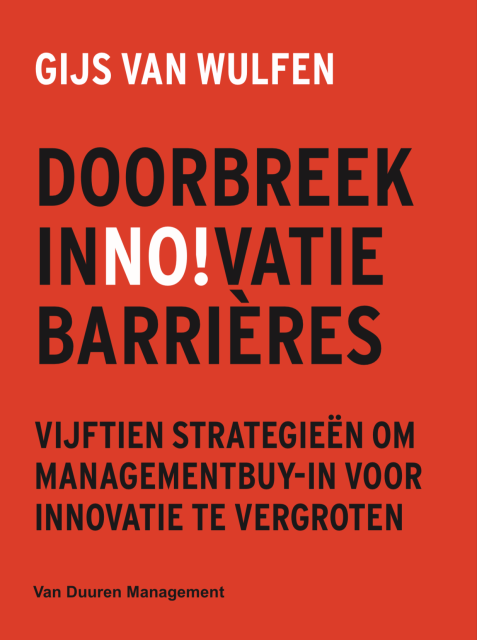 Doorbreek Innovatiebarrières
Doorbreek Innovatiebarrières
Tags: Design Thinking, Innovation, Open Innovation
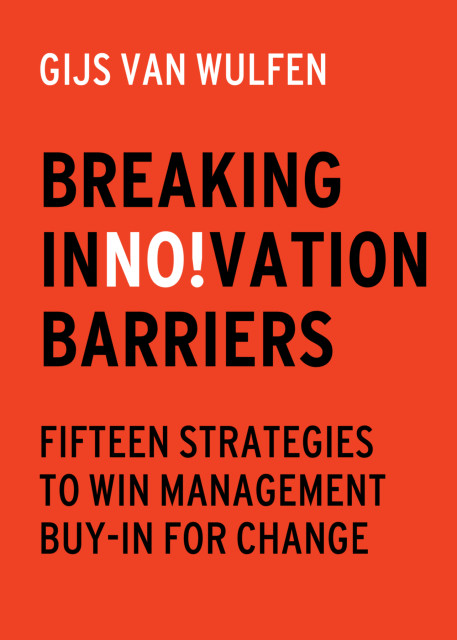 Breaking Innovation Barriers
Breaking Innovation Barriers
Tags: Design Thinking, Innovation, Open Innovation
 HYBRID Innovation (In Japanese)
HYBRID Innovation (In Japanese)
Tags: Design Thinking, Innovation, Open Innovation
 Online Innovation: Tools, Techniques, Methods and Rules to Innovate Online
Online Innovation: Tools, Techniques, Methods and Rules to Innovate Online
Tags: Design Thinking, Entrepreneurship, Innovation
 The Innovation maze (in Japanese)
The Innovation maze (in Japanese)
Tags: Design Thinking, Innovation, Open Innovation
 SPEDIZIONE PER INNOVARE
SPEDIZIONE PER INNOVARE
Tags: Design Thinking, Entrepreneurship, Innovation
 Inspiratie voor Innovatie
Inspiratie voor Innovatie
Tags: Design Thinking, Entrepreneurship, Innovation
 Inspiration for Innovation
Inspiration for Innovation
Tags: Design Thinking, Innovation, Startups
 La expedición hacia la innovación (Edición mexicana)
La expedición hacia la innovación (Edición mexicana)
Tags: Design Thinking, Entrepreneurship, Innovation
 Innoveer Jezelf
Innoveer Jezelf
Tags: Design Thinking, Entrepreneurship, Innovation
 Innovation map: create customers need products and services (full color)(Chinese Edition)
Innovation map: create customers need products and services (full color)(Chinese Edition)
Tags: Design Thinking, Entrepreneurship, Innovation
 The Innovation Maze
The Innovation Maze
Tags: Design Thinking, Entrepreneurship, Innovation
 Het Innovatiedoolhof
Het Innovatiedoolhof
Tags: Design Thinking, Entrepreneurship, Innovation
 The Innovation Maze
The Innovation Maze
Tags: Design Thinking, Innovation, Startups
 Sutato inobeshon : Bijinesu inobeshon o hajimeru tame no jissen bijuaru gaido ando shiko tsuru kitto
Sutato inobeshon : Bijinesu inobeshon o hajimeru tame no jissen bijuaru gaido ando shiko tsuru kitto
Tags: Design Thinking, Entrepreneurship, Innovation
 Inovasyon Seferi (The Innovation Expedition in Turkish)
Inovasyon Seferi (The Innovation Expedition in Turkish)
Tags: Design Thinking, Innovation, Open Innovation
 The Innovation Expedition
The Innovation Expedition
Tags: Creativity, Design Thinking, Innovation
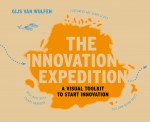 The Innovation Expedition
The Innovation Expedition
Tags: Design Thinking, Entrepreneurship, Innovation
 Creating Innovative Products and Services
Creating Innovative Products and Services
Tags: Design Thinking, Entrepreneurship, Innovation
 Nieuwe Producten en Diensten Bedenken
Nieuwe Producten en Diensten Bedenken
Tags: Design Thinking, Entrepreneurship, Innovation
 NIeuwe Producten Bedenken (second edition - Dutch)
NIeuwe Producten Bedenken (second edition - Dutch)
Tags: Design Thinking, Innovation, Open Innovation
 NIeuwe Producten Bedenken (first edition - Dutch)
NIeuwe Producten Bedenken (first edition - Dutch)
Tags: Design Thinking, Innovation, Open Innovation
 Nomination for the PIM Literature Prize 2021
Nomination for the PIM Literature Prize 2021
Tags: Creativity, Innovation
 Groot Innovatie Modellenboek
Groot Innovatie Modellenboek
Tags: Design Thinking, Innovation, Open Innovation
 Creativiteit Hoe Zo?
Creativiteit Hoe Zo?
Tags: Creativity, Design Thinking, Innovation
 Founder of the FORTH Innovation Institute
Founder of the FORTH Innovation Institute
Tags: Design Thinking, Innovation, Startups
 Management Book of The Year
Management Book of The Year
Tags: Creativity, Innovation
 Are Corporate Ventures Killing Internal Innovation?
Are Corporate Ventures Killing Internal Innovation?
Tags: Design Thinking, Entrepreneurship, Innovation
 Learn How to Facilitate Innovation in One Week
Learn How to Facilitate Innovation in One Week
Tags: Design Thinking, Entrepreneurship, Innovation
 Understanding Customers for Innovation
Understanding Customers for Innovation
Tags: Design Thinking, Entrepreneurship, Innovation
 Fifty Methods for Innovators
Fifty Methods for Innovators
Tags: Design Thinking, Entrepreneurship, Innovation
 Why People Reject Your Ideas? Watch The TedTalk!
Why People Reject Your Ideas? Watch The TedTalk!
Tags: Design Thinking, Entrepreneurship, Innovation
 Thirteen Soft Skills You Must Master (in Innovation)
Thirteen Soft Skills You Must Master (in Innovation)
Tags: Design Thinking, Innovation
 A Unique Learning Opportunity for Innovators
A Unique Learning Opportunity for Innovators
Tags: Design Thinking, Innovation
 Ideas for What ...? How to Get a Clear Focus for Innovation
Ideas for What ...? How to Get a Clear Focus for Innovation
Tags: Creativity, Design Thinking, Innovation
 9 Habits of Highly Effective Facilitators (Free Webinar)
9 Habits of Highly Effective Facilitators (Free Webinar)
Tags: Design Thinking, Innovation, Open Innovation
 How Top Innovators Use the Yerkes-Dodson Law to Boost Team Creativity
How Top Innovators Use the Yerkes-Dodson Law to Boost Team Creativity
Tags: Creativity, Design Thinking, Innovation
 Harmonyvation: the Way to Spark a Culture for Innovation in a Big Organisation
Harmonyvation: the Way to Spark a Culture for Innovation in a Big Organisation
Tags: Creativity, Design Thinking, Innovation
 Ten Reasons for Top Managers to Innovate while Mitigating Risks
Ten Reasons for Top Managers to Innovate while Mitigating Risks
Tags: Creativity, Design Thinking, Innovation
 Doorbreek Innovatiebarrières
Doorbreek Innovatiebarrières
Tags: Design Thinking, Innovation, Open Innovation
 Breaking Innovation Barriers
Breaking Innovation Barriers
Tags: Design Thinking, Innovation, Open Innovation
 Breaking Innovation Barriers
Breaking Innovation Barriers
Tags: Design Thinking, Innovation, Open Innovation
 How to Innovate the Expedition Way
How to Innovate the Expedition Way
Tags: Design Thinking, Innovation, Open Innovation
 Inspiration for Innovation - Inspiratie voor Innovatie
Inspiration for Innovation - Inspiratie voor Innovatie
Tags: Design Thinking, Innovation, Open Innovation
 Ten lessons to Become a Great Innovator
Ten lessons to Become a Great Innovator
Tags: Design Thinking, Innovation, Open Innovation
 Ten Guidelines on Your Path Becoming an Amazing Innovator
Ten Guidelines on Your Path Becoming an Amazing Innovator
Tags: Creativity, Entrepreneurship, Innovation, Startups
Tags: Creativity, Design Thinking, Innovation
 TEDx Talk: Why People Reject Ideas
TEDx Talk: Why People Reject Ideas
Tags: Creativity, Innovation
 How to innovate Bulgaria?
How to innovate Bulgaria?
Tags: Creativity, Innovation
 Ten Guidelines on your path to becoming an amazing innovator
Ten Guidelines on your path to becoming an amazing innovator
Tags: Creativity, Innovation
 10 Tips om een geweldige innovator te worden
10 Tips om een geweldige innovator te worden
Tags: Creativity, Innovation
 How to Create a Culture for Innovation in a Big Japanese Corporation?
How to Create a Culture for Innovation in a Big Japanese Corporation?
Tags: Design Thinking, Innovation, Startups
 How to Create a Culture for Innovation?
How to Create a Culture for Innovation?
Tags: Design Thinking, Innovation, Startups
 How to Create a Culture for Innovation in Japan?
How to Create a Culture for Innovation in Japan?
Tags: Creativity, Innovation
Tags: Creativity, Innovation
 How to Start Innovation Effectively in Japan
How to Start Innovation Effectively in Japan
Tags: Design Thinking, Entrepreneurship, Innovation
 How to Start a Culture for Innovation?
How to Start a Culture for Innovation?
Tags: Culture, Entrepreneurship, Innovation
 How to Start Innovation Effectively
How to Start Innovation Effectively
Tags: Entrepreneurship, Innovation, Open Innovation
 How to be a great innovator
How to be a great innovator
Tags: Design Thinking, Entrepreneurship, Innovation
 How to Navigate The Innovation Maze
How to Navigate The Innovation Maze
Tags: Entrepreneurship, Innovation, Open Innovation
 How to Start Innovation Effectively in Mexico
How to Start Innovation Effectively in Mexico
Tags: Design Thinking, Entrepreneurship, Innovation
 How to Navigate The Innovation Maze
How to Navigate The Innovation Maze
Tags: Entrepreneurship, Innovation, Open Innovation
 How to Create a Culture for Innovation in Public Services
How to Create a Culture for Innovation in Public Services
Tags: Entrepreneurship, Innovation, Open Innovation
 How to innovate a SMART city?
How to innovate a SMART city?
Tags: Innovation, Open Innovation, Startups
 Book Launch Breaking Innovation Barriers
Book Launch Breaking Innovation Barriers
Tags: Design Thinking, Innovation, Open Innovation

Tags: Design Thinking, Entrepreneurship, Innovation
 Certified FORTH Innovation Training Italy - June 2025
Certified FORTH Innovation Training Italy - June 2025
Tags: Design Thinking, Innovation, Open Innovation
 Certified FORTH Innovation Training Japan - May 2025
Certified FORTH Innovation Training Japan - May 2025
Tags: Design Thinking, Innovation, Open Innovation
 Training new certified facilitators of the FORTH Innovation Methodology
Training new certified facilitators of the FORTH Innovation Methodology
Tags: Design Thinking, Innovation, Open Innovation
 Yearly 'live' 6-day Training of New Certified Facilitators of the FORTH Innovation Method in Japan
Yearly 'live' 6-day Training of New Certified Facilitators of the FORTH Innovation Method in Japan
Tags: Culture, Innovation, Open Innovation
 'live' 6-day Training of New Certified Facilitators of the FORTH Innovation Method 2013-2023
'live' 6-day Training of New Certified Facilitators of the FORTH Innovation Method 2013-2023
Tags: Culture, Innovation, Open Innovation
 6-day 'live' FORTH Innovation Training in Japan
6-day 'live' FORTH Innovation Training in Japan
Tags: Design Thinking, Innovation, Open Innovation
 '100% ONLINE' Training of New Certified Facilitators of the FORTH Innovation Method 2020-2022
'100% ONLINE' Training of New Certified Facilitators of the FORTH Innovation Method 2020-2022
Tags: Culture, Innovation, Open Innovation
 6-week Online Training as Certified FORTH Innovation Facilitator - NEOGEN USA
6-week Online Training as Certified FORTH Innovation Facilitator - NEOGEN USA
Tags: Design Thinking, Innovation, Open Innovation
 6-day Live Training as Certified FORTH Innovation Facilitator - NEC Japan
6-day Live Training as Certified FORTH Innovation Facilitator - NEC Japan
Tags: Design Thinking, Innovation, Open Innovation
 6-day Design Thinking Innovation Training In-company ACHMEA
6-day Design Thinking Innovation Training In-company ACHMEA
Tags: Design Thinking, Innovation, Open Innovation
 3-day Design Thinking Innovation Training in Bangalore - India
3-day Design Thinking Innovation Training in Bangalore - India
Tags: Design Thinking, Innovation, Open Innovation
 2016 Training Management Talents of Airbus on 'How to Start Innovation'
2016 Training Management Talents of Airbus on 'How to Start Innovation'
Tags: Design Thinking, Entrepreneurship, Innovation
 2-day Design Thinking Innovation Training In-company ACHMEA
2-day Design Thinking Innovation Training In-company ACHMEA
Tags: Design Thinking, Innovation, Open Innovation
 6-day Design Thinking Innovation Training In-company FAST TRACK
6-day Design Thinking Innovation Training In-company FAST TRACK
Tags: Design Thinking, Innovation, Open Innovation
 3-day Design Thinking Innovation Training in Birmingham - UK
3-day Design Thinking Innovation Training in Birmingham - UK
Tags: Design Thinking, Innovation, Open Innovation
 Do You Need an MBA to be an Innovator?
Do You Need an MBA to be an Innovator?
Tags: Design Thinking, Innovation, Open Innovation
 Innovation in Family Businesses
Innovation in Family Businesses
Tags: Design Thinking, Innovation, Open Innovation
 Learn how to fail intelligently
Learn how to fail intelligently
Tags: Design Thinking, Innovation, Open Innovation
 Soft Innovation Skills are Hard
Soft Innovation Skills are Hard
Tags: Design Thinking, Innovation, Open Innovation
 Is Improvement better than Innovation?
Is Improvement better than Innovation?
Tags: Design Thinking, Innovation, Open Innovation
 Is Design Thinking Dead?
Is Design Thinking Dead?
Tags: Design Thinking, Innovation, Open Innovation

Tags: Design Thinking, Entrepreneurship, Innovation

Tags: Creativity, Design Thinking, Innovation

Tags: Design Thinking, Innovation, Creativity

Tags: Design Thinking, Innovation, Creativity

Tags: Design Thinking, Innovation, Creativity

Tags: Design Thinking, Innovation, Creativity

Tags: Design Thinking, Innovation, Creativity

Tags: Design Thinking, Innovation, Creativity

Tags: Design Thinking, Innovation, Creativity

Tags: Design Thinking, Innovation, Creativity

Tags: Design Thinking, Innovation, Creativity

Tags: Design Thinking, Innovation, Creativity

Tags: Design Thinking, Innovation, Creativity
 Breaking Innovation Barriers
Breaking Innovation Barriers
Tags: Design Thinking, Innovation, Open Innovation
 Breaking Innovation Barriers
Breaking Innovation Barriers
Tags: Design Thinking, Innovation, Open Innovation
 How to Apply AI in Innovation?
How to Apply AI in Innovation?
Tags: AI, Innovation, Startups
 How to Innovate The Hybrid Way?
How to Innovate The Hybrid Way?
Tags: Digital Transformation, Innovation, Open Innovation
 How to Innovate Japan Online?
How to Innovate Japan Online?
Tags: Digital Transformation, Innovation, Open Innovation
 How to Start Innovation the Right Way?
How to Start Innovation the Right Way?
Tags: Culture, Entrepreneurship, Innovation
 The Manifesto for Future-Fit Organisations
The Manifesto for Future-Fit Organisations
Tags: Digital Transformation, Innovation, Open Innovation
 The Innovation Maze in Japan
The Innovation Maze in Japan
Tags: Digital Transformation, Innovation, Open Innovation
 How to innovate Online?
How to innovate Online?
Tags: Digital Transformation, Innovation, Open Innovation
 How to Innovate Online
How to Innovate Online
Tags: Digital Transformation, Innovation, Open Innovation
 How to Start a Culture for Innovation?
How to Start a Culture for Innovation?
Tags: Culture, Innovation, Open Innovation
 How to Start Innovation effectively?
How to Start Innovation effectively?
Tags: Entrepreneurship, Innovation, Open Innovation
 a 15-week, 15-workshop 'live' innovation journey with The Dutch Institute for Beeld & Geluid
a 15-week, 15-workshop 'live' innovation journey with The Dutch Institute for Beeld & Geluid
Tags: Entrepreneurship, Innovation, Open Innovation
 How to Create a Culture for Innovation?
How to Create a Culture for Innovation?
Tags: Design Thinking, Innovation, Startups
 A 15-week, 15-workshops FORTH Innovation Journey with Wärtsilä, Finland
A 15-week, 15-workshops FORTH Innovation Journey with Wärtsilä, Finland
Tags: Entrepreneurship, Innovation, Open Innovation
 a 15-week, 15-workshop 'live' innovation journey with Continental Candy Industries
a 15-week, 15-workshop 'live' innovation journey with Continental Candy Industries
Tags: Emerging Technology, Innovation, Open Innovation
 a 15-week, 15-workshop online innovation journey with Philip Morris International
a 15-week, 15-workshop online innovation journey with Philip Morris International
Tags: Emerging Technology, Innovation, Open Innovation
 a 15-week, 15-workshop 'live' innovation journey with Huntsman Europe
a 15-week, 15-workshop 'live' innovation journey with Huntsman Europe
Tags: Emerging Technology, Innovation, Open Innovation
 a 15-week, 15-workshop 'live' innovation journey with Dutch SME: BRUIL
a 15-week, 15-workshop 'live' innovation journey with Dutch SME: BRUIL
Tags: Emerging Technology, Innovation, Open Innovation
 a 15-week, 15-workshop 'live' innovation journey with Language Institute Regina Coeli
a 15-week, 15-workshop 'live' innovation journey with Language Institute Regina Coeli
Tags: Emerging Technology, Innovation, Open Innovation
Date : January 25, 2024
Date : January 27, 2024
 How to Make Executives Say Yes to Your Innovation Projects
How to Make Executives Say Yes to Your Innovation Projects
Internal resistance, bureaucracy and a lack of leadership support are just two of the common roadblocks you face as innovator when bringing ideas to life in an organisation.
If you’re an innovation consultant, intrapreneur, or leader struggling to get buy-in for your ideas, then Breaking Innovation Barriers by Gijs van Wulfen is a must-read. This book provides you with 15 proven strategies to overcome corporate resistance and gain management support, making it an invaluable resource for anyone involved in innovation.
But what makes this book stand out in a crowded market of business and innovation literature? Here are five compelling reasons why innovators should read Breaking Innovation Barriers and how it can help you succeed.
1. Identifying and Understanding the 15 Most Common Innovation Barriers
One of the biggest challenges innovators face is not knowing exactly what is preventing their ideas from gaining traction. Many innovators hope that a good idea will naturally be accepted—but, as you know so well, the reality is far more complex.
Gijs van Wulfen’s book systematically identifies 15 common barriers that stop innovation in organisations, including:
• Risk aversion and fear of failure – Many managers and employees hesitate to embrace new ideas because they fear the consequences of failure.
• Lack of priority – Without a clear business case, leadership may not see innovation as a priority.
• Silo mentality – Departments work in isolation, making collaboration and cross-functional innovation difficult.
• Budget constraints – Even promising innovations struggle when financial resources are limited.
• Short-term focus – Many organisations prioritise quarterly results over long-term growth, making it difficult to justify investment in innovation.
By recognising these barriers, you can develop targeted strategies to overcome them rather than wasting energy fighting invisible forces. Instead of just pushing harder, innovators can work smarter, adjusting their approach to address the real underlying issues.
“Most managers only innovate when doing nothing is a bigger risk” – Gijs van Wulfen
Understanding these barriers is the first step toward breaking through them. This book provides a roadmap for innovators to diagnose and address the specific challenges they face within their organisations.
2. Proven Strategies to Secure Management Buy-In
Even the best ideas will fail if they don’t have leadership support. One of the most frustrating experiences for innovators is presenting an idea with great potential—only to be met with resistance, skepticism, or indifference from top management.
Van Wulfen’s book provides 15 concrete strategies for winning over executives and decision-makers, including:
• Understanding your management deeply– Instead of focusing on creativity and possibilities, frame innovation in terms of return on investment (ROI), risk mitigation, and strategic advantage, based on an understanding of what they really want.
• Experiment: starting small and proving value – Instead of asking for a huge budget upfront, implement a small, low-risk pilot project to demonstrate the concept’s value.
• Aligning with strategic goals– Innovations that clearly support the company’s mission and strategic objectives are much more likely to receive support
• Building internal coalitions – Creating innovation ambassadors by gaining buy-in from multiple stakeholders before approaching leadership can significantly improve your chances of success.
Many innovators make the mistake of assuming that good ideas sell themselves. The reality is that innovation is a political and strategic process. This book teaches you how to navigate that process effectively, ensuring your ideas don’t just sound good on paper but actually get implemented.
“Innovation without management support is like sailing without wind.” – Gijs van Wulfen
3. Real-World Innovation Stories That Provide Practical Lessons
Theory is useful, but real-world examples bring ideas to life. One of the strengths of Breaking Innovation Barriers is that it doesn’t just provide advice—it backs up every strategy with actual case studies from successful innovators.
For example, the book explores:
• How SAP created a safezone to experiment and boosted internal innovation effectiveness.
• How SEA, the Airports of Milano, used a WEnovation approach to unite internal silos and boost innovation successfully.
• How BRUIL, a midsize concrete company, took off on an innovation journey creating the largest 3D printed concrete project of the world.
• How proven methodologies helped NTTDATA, a 100.000+ IT company, to innovate Japan.
These and other stories provide powerful lessons and actionable takeaways that innovators can apply in their own industries.
Innovation is not just about new ideas; it’s about creating impact.” – Gijs van Wulfen
By learning from those who have successfully navigated similar challenges, readers can avoid common pitfalls and accelerate their own innovation journey.
4. Ensuring That Innovation Aligns with Organisational Strategy
One of the most common reasons innovation initiatives fail is because they are seen as side projects rather than essential parts of the organization’s strategy. Too often, innovation is treated as an isolated effort led by a single department rather than an integrated approach that supports the company’s larger goals.
This book emphasizes the importance of strategic alignment and teaches innovators how to:
• Frame innovation in terms of business growth – Instead of presenting ideas as “nice-to-have” experiments, tie them directly to key performance indicators (KPIs) and revenue growth.
• Work within existing company priorities – Innovation efforts that align with corporate initiatives (such as digital transformation or sustainability) are more likely to be supported.
• Use strategic timing – Launching an innovation initiative at the right moment—such as when a company is looking for new revenue streams—can significantly improve its chances of success.
“An innovator should have the patience of a hunter to pick the right moment.” – Gijs van Wulfen
By following the principles in this book, innovators can ensure that their efforts are not just tolerated but actively supported as critical to the company’s future success.
5. Practical Tools, Inspiring Quotes, and Actionable Takeaways
The book is not just filled with ideas—it’s packed with practical tools and motivational insights to help innovators take action. Each strategy comes with step-by-step guidance on how to implement it, making it easy for readers to apply the lessons in their own work.
Some highlights include:
• Frameworks for pitching innovation to executives
• Checklists for identifying and overcoming specific barriers
• Templates for creating compelling business cases for new ideas
• Inspiring quotes and anecdotes from successful innovators
Many innovation books offer high-level theory but lack concrete guidance on execution. Breaking Innovation Barriers is different—it’s a hands-on playbook designed to help innovators take action immediately.
“The best guarantee to win management buy-in for innovation is a launching customer.” – Gijs van Wulfen
Final Verdict: A Must-Read for Innovators
With a 5-star rating on Amazon, Breaking Innovation Barriers has been praised by innovation leaders worldwide. One reviewer called it:
“An absolute must-read for innovation leaders, idea generators, and anyone looking to successfully navigate innovations through organizations.”
If you’re an innovator struggling to get your ideas accepted, this book will equip you with the knowledge, tools, and confidence to break through resistance and drive meaningful change.
Don’t let bureaucracy, resistance, or lack of support kill your best ideas. Grab a copy of Breaking Innovation Barriers and turn your innovations into reality.
Tags: Design Thinking, Innovation, Open Innovation
 Six Innovation Hats. Which One Fits You?
Six Innovation Hats. Which One Fits You?
Depending on your role, attitude, and background, senior managers and C-suite
executives may see innovation quite differently and expect different outcomes, as you can see in the picture above with the six innovation hats.
The researcher, the engineer, the investor, the advocate, the motivator, and the
organiser all have different perspectives, all valid and true.
So, get to know your top manager first to get a proper impression of his or her background and how they define innovation.
‘Understand your Management’ is the first of 15 strategies to win management buy-in for innovation from the new book ‘Breaking Innovation Barriers’.
Check it out now on Amazon to win management buy-in for innovation making you an impactful innovator.
Ps. The six hats were published in an article in HBR, 2019/11 “What kind of chief innovation officer your company need.”
Tags: Creativity, Design Thinking, Innovation
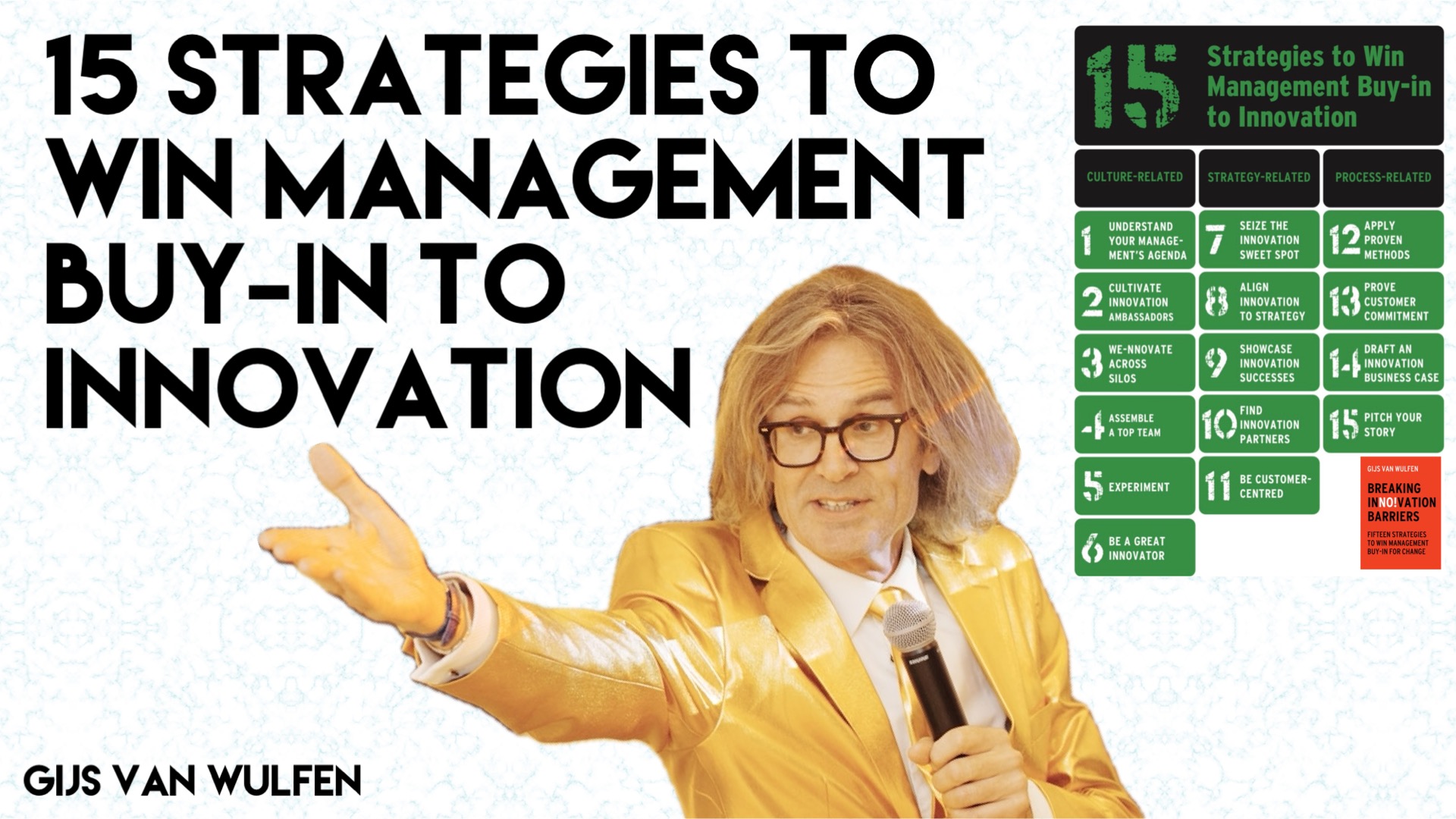 Win Management Buy-In for Innovation with Fifteen Proven Strategies …
Win Management Buy-In for Innovation with Fifteen Proven Strategies …
Innovation is hard. You’ve got the ideas, the energy, and the passion. But without management support, you’re going nowhere fast. As innovators, we face resistance at every turn. We’re told “no” more often than “yes.” But the good news? There are strategies to turn those “no’s” into “yes’s.”
Let me walk you through 15 practical strategies to win the buy-in you need to get your innovation off the ground.
1. Understand What Your Managers Care About
To get their support, you need to know what makes your managers tick. What are their priorities? Align your innovation proposal with their goals, and you’ll stand a better chance of getting the green light.
2. Build a Team of Innovation Ambassadors
Find like-minded people in your organisation who believe in innovation. Create a network of supporters who can help champion your ideas. This informal team can make a huge difference in spreading enthusiasm and driving change.
3. Break Down Silos—We-nnovate, Don’t I-nnovate
Silos kill innovation. When teams work in isolation, new ideas get stuck. Get departments talking to each other. Encourage collaboration across the business. When we stop working in silos and start “we-nnovating,” magic happens.
4. Assemble Your Dream Team
Innovation is all about people. You need the right team to make it happen. Find individuals who are passionate, skilled, and ready to drive change. Senior managers will only back you if they trust the people leading the innovation charge.
5. Experiment, Experiment, Experiment
Managers love data. They don’t want opinions; they want proof. Run experiments to show what works and what doesn’t. Create a safe space where failure is okay, as long as you learn and adapt quickly. “Fail fast or scale fast” should be your mantra.
6. Timing Is Everything—Seize the Sweet Spot
Most companies focus on today’s business over tomorrow’s innovation. Wait for the right moment. The sweet spot usually comes when there’s a new strategy or a change in leadership. That’s when they’re most open to new ideas.
7. Align Innovation with Business Strategy
Make sure your innovation efforts directly support the company’s long-term goals. If you can show that your idea helps achieve strategic objectives, you’ll have a stronger case to win buy-in.
8. Highlight Past Successes
Your company has innovated before. Remind your managers of past wins and how they led to growth. Use those examples to demonstrate the value of supporting future innovation.
9. Find External Partners
Sometimes, the best innovations come from partnerships. Collaborate with external partners—customers, suppliers, universities—to bring fresh ideas into your organisation. This can help accelerate innovation and reduce risk.
10. Focus on the Customer
Innovation should always start with the customer. What are their challenges? How can your idea solve them? Keep the customer at the centre of your innovation process, and you’ll be more likely to create something truly impactful.
11. Use Proven Methods
There’s no need to reinvent the wheel. Use proven innovation methodologies to guide your process. It reduces uncertainty and helps gain the trust of management.
12. Show Customer Commitment
Got a new concept? Get potential customers to commit to it. When you can show that customers are ready to buy, it becomes much easier to get your managers to invest.
13. Create a Solid Business Case
Your innovation might be brilliant, but without a strong business case, it won’t get far. Outline the costs, benefits, risks, and potential returns. Give your managers the information they need to make an informed decision.
14. Craft a Great Story
Don’t just present the facts—tell a story. Paint a picture of what the future could look like with your innovation. Make it personal, make it real, and make it exciting. A great story is what gets people on board.
15. Be the Best Innovator You Can Be
Finally, you are part of the equation. It’s not just the idea; it’s about trust. Management needs to believe that you’re the right person to lead the innovation. Build relationships, show your commitment, and be the innovator they can rely on.
Turn Nos into Yesses
Winning management buy-in is never easy. But by following these 15 strategies, you’ll be better equipped to navigate the challenges and get the support you need.
In my new book, “Breaking Innovation Barriers”, I dive deeper into each of these strategies. Packed with practical tips and real-life examples, it’s your guide to turning those frustrating “no’s” into enthusiastic “yes’s.”
Check it out in the comments, pre-order it at Amazon, and take the first step to becoming an unstoppable innovator.
#Breakinginnovationbarriers #book #innovation #strategiestowinmanagementbuyin
Tags: Design Thinking, Innovation, Open Innovation
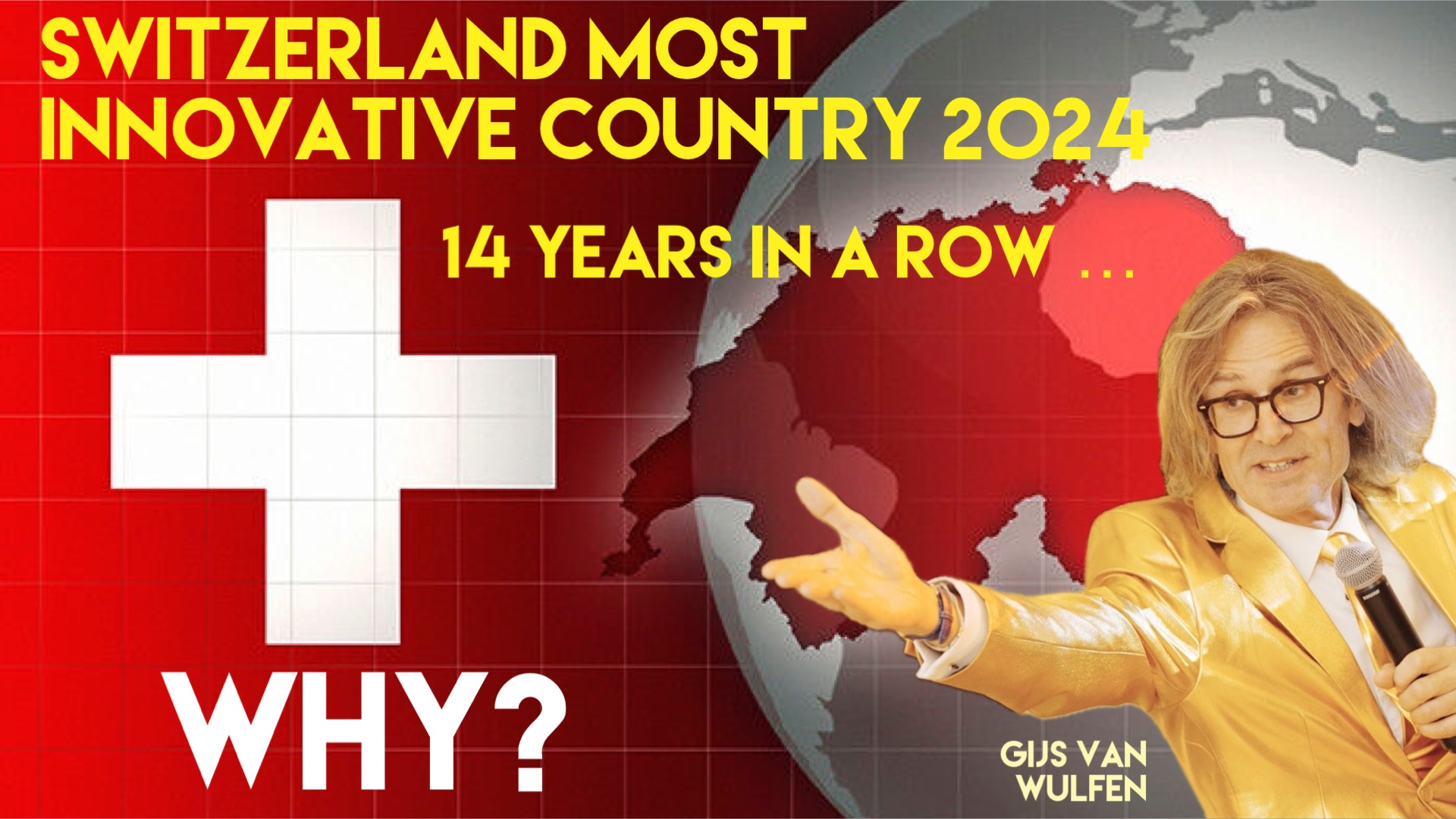 The Most Innovative Country of the World in 2024 is…
The Most Innovative Country of the World in 2024 is…
The Most Innovative Country of the World in 2024 is…
According to the World Intellectual Property Organization’s (WIPO) Global Innovation Index (GII), the top spot in 2024 belongs to Switzerland, once again!
Let’s explore what makes it shine—and why it’s relevant for us, as professionals looking to lead. Why Switzerland? Switzerland has topped the Global Innovation Index for years. In 2024, it’s no different. But what makes it so special? Here’s the secret: Switzerland excels because of its unique ecosystem of innovation. The country invests heavily in education, has a high-quality research infrastructure, and strong collaboration between business and academia. It’s not just about throwing money at problems—it’s about building a culture of continuous improvement. In short: Switzerland has built a well-oiled innovation machine that doesn’t rely on any one factor but on a whole ecosystem working together.
The 2024 Innovation Rankings: Now, Switzerland didn’t just sneak into first place. It secured the top spot convincingly. Here’s how the top 10 ranks for 2024: 1. Switzerland 2. Sweden 3. United States 4. Singapore 5. United Kingdom 6. South Korea 7. Finland 8. Netherlands 9. Germany 10. Denmark
While these countries all rank high, Switzerland consistently stands out for its holistic approach. What We Can Learn From Switzerland As professionals, we should look beyond the what and dive into the how. Switzerland’s approach has lessons for anyone looking to foster innovation:
1. Build Partnerships: Don’t innovate in isolation. Whether it’s universities, competitors, or government agencies—collaborate! Build an ecosystem that supports diverse input.
2. Invest in Talent: Switzerland’s success rests on a skilled workforce. As leaders, investing in people is non-negotiable if you want to stay ahead.
3. Focus on R&D: Research isn’t just for scientists. Even in business, investing in ‘exploring new ideas’ can set you apart. Create time for discovery in your teams.
4. Think Long-Term: The Swiss didn’t get to the top overnight. Their long-term focus on education, infrastructure, and innovation has built a lasting foundation. Patience pays off.
5. Go Global: Innovation today knows no borders. Engage in international networks, leverage global talent, and be open to ideas from everywhere.
Conclusion: Switzerland isn’t a magical exception. The reason it remains the most innovative country in 2024 is simple: it follows best practices consistently and invests heavily in the future. For us, the lesson is clear. If we want to drive innovation in our organizations, we need to invest in people, partnerships, and processes. So, what’s your plan for fostering innovation in 2024?
#GII #GII2024 #mostinnovativecountry #innovation
Tags: Design Thinking, Innovation, Open Innovation
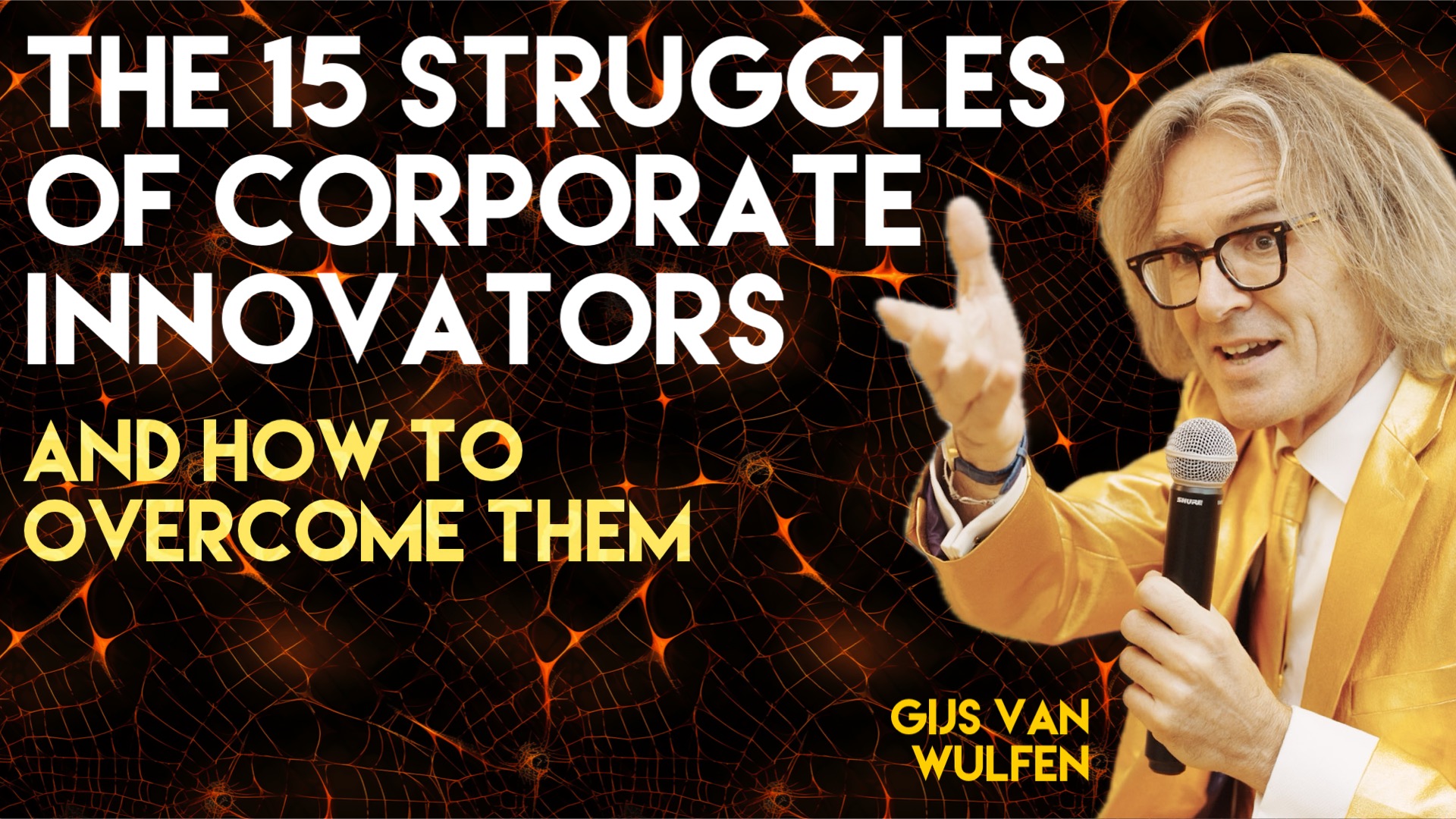 The 15 Struggles of Corporate innovators
The 15 Struggles of Corporate innovators
Management knows innovation is important, but find all kind of reasons to stop it continuously. Check out in this article the main struggles of corporate innovators and how to overcome them to increase your innovation impact ... breaking innovation barriers.
Innovation is critical. If your organisation doesn’t keep up with external changes, you risk becoming irrelevant. Research shows the lifespan of S&P 500 companies has plummeted from 61 years in 1958 to just 18 years today. The companies that failed? They didn’t innovate in time.
Many associate innovation with tech, but it’s broader than that. Yes, it could be about AI, biotech, or robotics, but it’s also about new business models, processes, or ways of working. It’s not just about invention. Innovation is about taking those ideas and turning them into reality—something that has an impact, whether it’s a new service, product, or approach. And that impact might be enormous, affecting how people think, act, or work. It could also have a quantitative effect—reaching massive audiences. In either case, innovation means change.
But here’s the kicker: innovation isn’t easy. In fact, the biggest obstacle is something simple, yet infuriating. The word “No”.
You’ve heard it before:• “No, we’ve tried that.”• “No, it’s too risky.”• “No, it’s not in the budget.”• “No, our customers won’t like it.”Sound familiar?
These are the kinds of rejections that kill innovation. And it’s not just about technical feasibility. More often, innovation dies because of a lack of management support. This is echoed by 52% of LinkedIn professionals who say their biggest challenge is simply that management doesn’t back innovation enough.
Why Does Innovation Struggle? Management knows innovation is important. They say it all the time. But they’re also dissatisfied with how it’s going. There’s a gap between their intentions and the reality of execution. They want incremental changes—small improvements over time. Radical ideas? They’re too scary, too much of a leap from the comfort zone.The truth is, innovation gets buried under daily priorities. CEOs know it’s vital for the future, but when push comes to shove, the immediate business needs always seem more pressing.
As I often say, “The business of today beats innovation for tomorrow.”
So, what happens to all those bright, disruptive ideas? They get killed. Not because they’re bad, but because they don’t get the chance to survive the bureaucratic gauntlet of “no’s.”
If you’re reading this, you probably know these struggles:1. Getting innovation on the corporate agenda. 2. Securing a budget for it. 3. Lack of senior management support. 4. Resistance from traditionalists. 5. Bureaucratic hurdles. 6. Aligning innovation with corporate strategy. 7. Facing internal competition for funding. 8. Dealing with risk-averse cultures. 9. Slow decision-making. 10. Organisational silos. 11. Attracting the right talent. 12. Skepticism about ROI. 13. Frustration with slow results. 14. Siloed thinking. 15. Resistance to new ideas. These challenges resonate with innovation professionals everywhere.
We’re battling against a corporate culture that both claims to love innovation but is quick to stifle it.
The good news? Innovation professionals aren’t alone. You have the ideas, the drive, and now, you need the support. Breaking these barriers is essential for future-proofing your organisation and maintaining relevance in an ever-changing world. That’s where my new book, “Breaking Innovation Barriers,” comes in. It dives deep into the practical ways you can navigate these obstacles, from securing management buy-in to creating an innovation culture that embraces risk and rewards forward-thinking ideas. You’ll find practical strategies and real-life examples to help break through the resistance and turn “no” into “yes.”
In Conclusion: Innovation is a Struggle—but You Can Win.
Yes, innovation is a struggle. It’s filled with resistance, obstacles, and frustrations. But it’s also necessary. Without it, companies fade, opportunities are missed, and the future becomes uncertain. You can overcome the “no’s.” You can break through the barriers. It just takes the right tools and strategies to push forward.Want to know how? Check out “Breaking Innovation Barriers” on Amazon, and pre-order now—it might just be the game-changer your (client's) organisation needs.
Wishing you lots of innovation success!
Innovative regards,
Gijs van Wulfen
Thinkers360 Global Number One Thought Leader on Design Thinking 2024
Tags: Design Thinking, Innovation, Open Innovation
 Five Innovation Mistakes You Should Avoid
Five Innovation Mistakes You Should Avoid
Innovators are the dreamers who turn ideas into reality. I am indeed; you too? Read further to learn from my five biggest mistakes …
Even the best minds stumble sometimes. If you’re on your innovation journey, you might recognise these mistakes. Don’t worry—it happens to everyone. Here are five common traps talentful innovators fall into, including me, and how to avoid them.
1. Falling in Love with your Idea
It’s easy to get attached to your idea. You think it’s brilliant (and it might be). But the truth is, not every idea is a winner. Innovators often get so hooked on their original concept, they ignore feedback or signs it’s not working. Don’t make your idea your identity. Be flexible. If it’s not solving a real problem, pivot.
Solution:Test early. Get feedbackas early as possible for example by pretotyping. Be willing to let go if needed.
2. Ignoring Your Market
You’ve got a breakthrough solution—but does anyone need it? Innovators often focus on creating the “next big thing” without checking if there’s a market for it. No matter how cool your innovation is, if it doesn’t solve a pain point or relevant customer friction as I coin it, for someone, it’s not going anywhere.
Solution: Do your customer research first. Understand your market and the relevant problem you’re solving.
3. Overcomplicating the Solution
Innovators love adding features. It's tempting to keep tweaking and making your product, service or business model more impressive. But more isn’t always better. Sometimes, simplicity wins. Overcomplicating can confuse your audience and make the solution harder to use.
Solution: Start simple. Launch with your core value. You can always add features later.
4. Innovating Solo
You can invent alone, but innovating isn’t a solo sport. It’s easy to think you can handle everything yourself, but even the most talented innovators need a team. Surround yourself with people who complement your skills and challenge your thinking.
Solution: Build a diverse team from the start. Don’t just look for people who agree with you—find those who add new perspectives.
5. Moving Too Fast (or Too Slow)
Speed is crucial in innovation, but both extremes can hurt you. Move too fast, and you might miss critical details. Move too slow, and someone else will beat you to market. Finding the right balance between attractiveness and feasibility is key.
Solution: Set realistic milestones. Keep momentum but don’t rush. Run the innovation marathon as a sprint.
In the end, mistakes are part of the innovation process. The key is to learn from them and keep pushing forward. Innovate smart, stay flexible, and remember—it’s the journey, not just the destination.
#innovationfailures #innovationpitfalls #innovationmistakes
Tags: Design Thinking, Innovation, Open Innovation
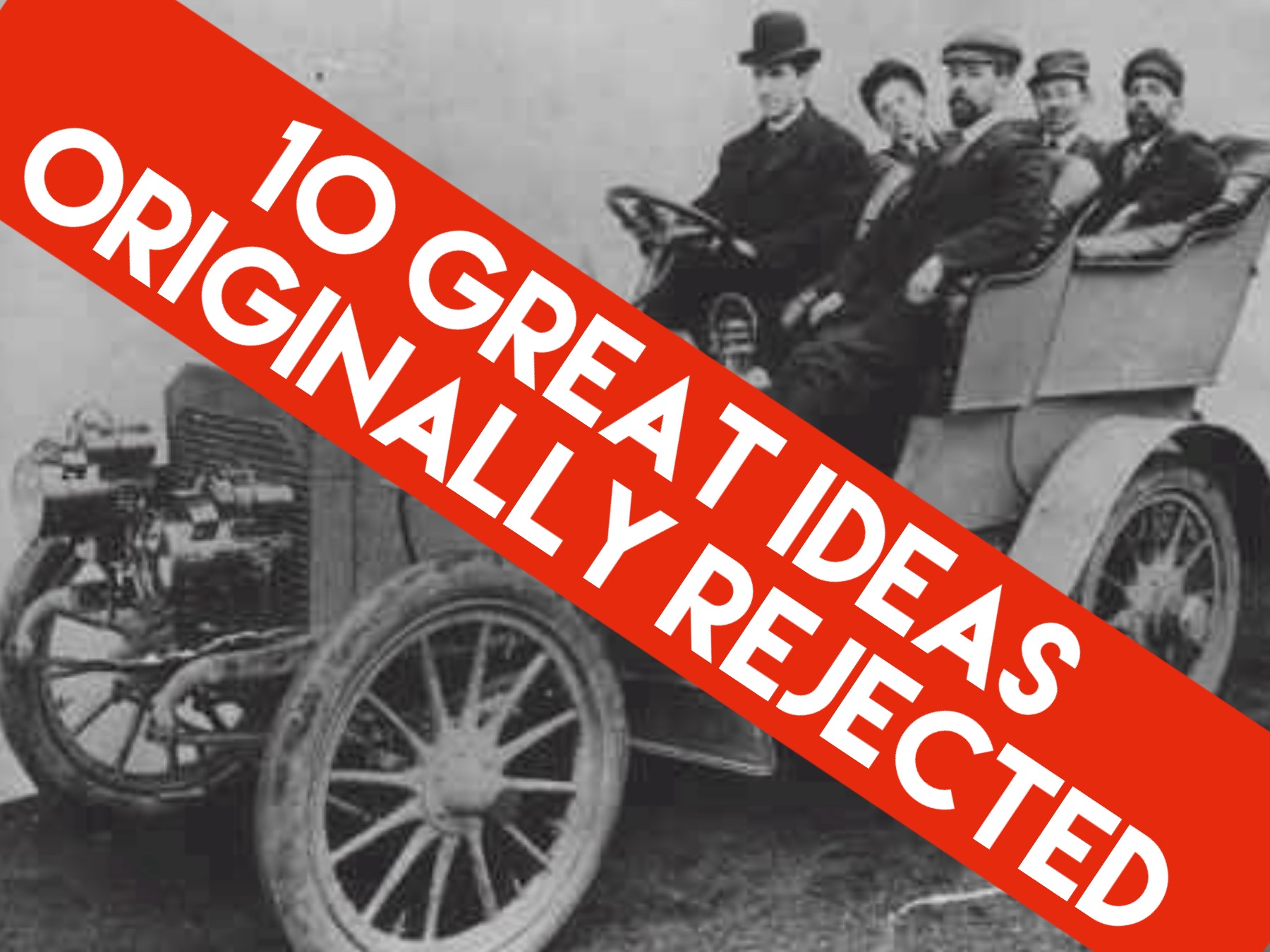 Ten Great Ideas Originally Rejected
Ten Great Ideas Originally Rejected
You cannot imagine which 10 great innovations originally were rejected …
"This 'telephone' has too many shortcomings to be considered as a means of communication. The device is inherently of no value to us."
Western Union internal memo, 1876.
"I do not believe the introduction of motor-cars will ever affect the riding of horses."
Mr. Scott-Montague, MP, United Kingdom, 1903.
"The wireless music box has no imaginable commercial value. Who would pay for a message sent to nobody in particular?"
David Sarnoff's Associates rejecting a proposal for investment in the radio, the 1920s.
"Who the hell wants to hear actors talk?"
H.M. Warner (Warner Brothers) before rejecting a proposal for movies with sound, 1927.
"This is typical Berlin hot air. The product is worthless." Letter sent by Heinrich Dreser, head of Bayer's Pharmacological Institute, rejecting Felix Hoffmann's invention of aspirin.
"Who the hell wants to copy a document on plain paper???" Rejection letter in 1940 to Chester Carlson, inventor of the XEROX machine.
"The concept is interesting and well-formed, but in order to earn better than a 'C,' the idea must be feasible." A Yale university professor in response to Fred Smith's paper proposing reliable overnight delivery service. Smith went on to found Federal Express.
"There is no reason anyone would want a computer in their home." Ken Olsen, President, Chairman and Founder of Digital Equipment Corp, 1977.
"You want to have consistent and uniform muscle development across all of your muscles? It can't be done. It's just a fact of life."
Rejection letter to Arthur Jones, who invented the Nautilus Fitness Machine.
"So we went to Atari and said, 'Hey, we've got this amazing thing, even built with some of your parts, and what do you think about funding us?' And they said, 'No.' So then we went to Hewlett-Packard, and they said, 'Hey, we don't need you. You haven't got through college yet.'"
Apple Computer Inc. founder Steve Jobs on attempts to get Atari and HP interested in his and Steve Wozniak's personal computers.
Wishing you lots of success with your judgment on innovative ideas,
Gijs
Tags: Creativity, Design Thinking, Innovation
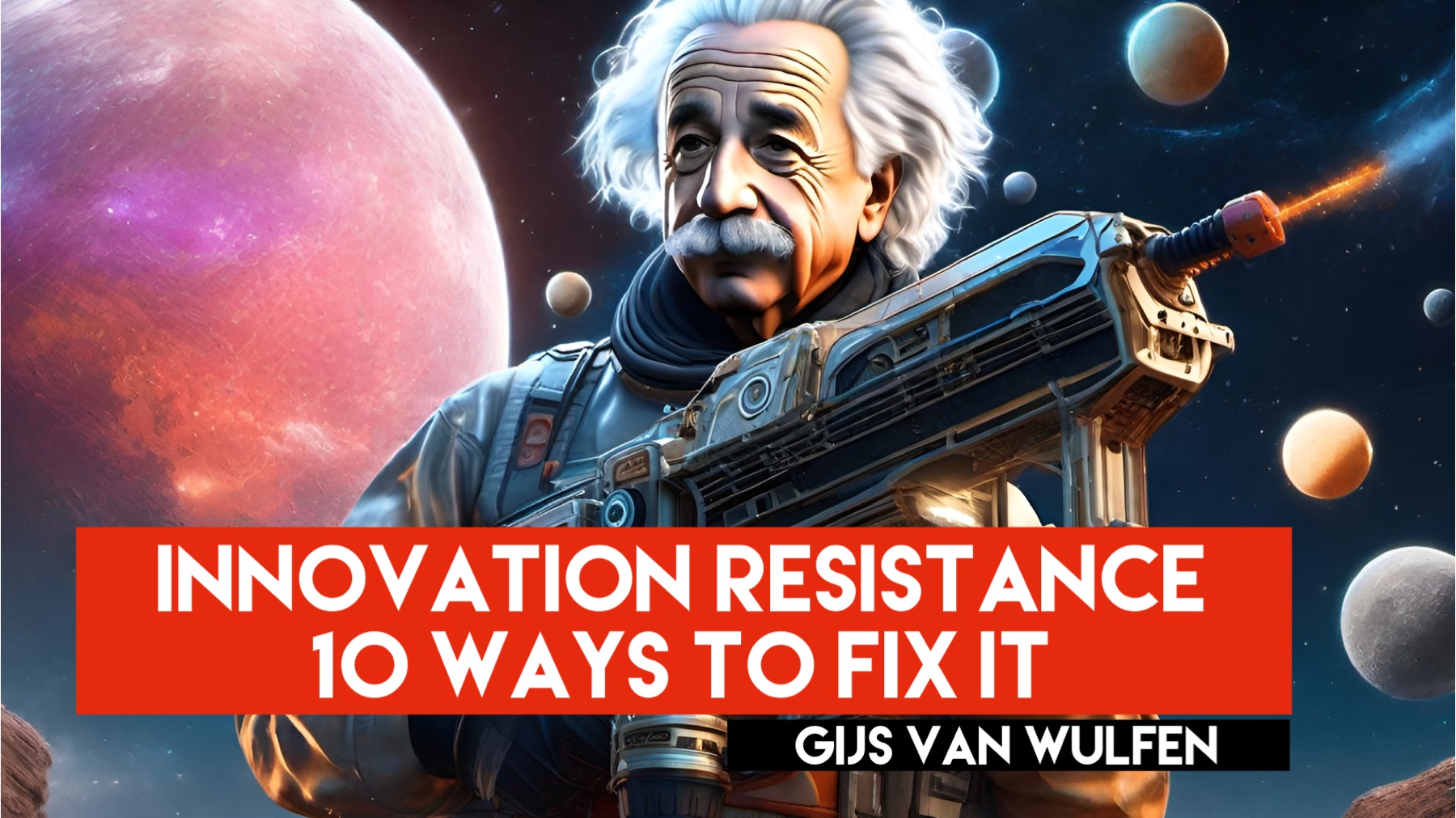 Ten Ways to Overcome Resistance to Innovation
Ten Ways to Overcome Resistance to Innovation
Innovation is often met with skepticism and resistance. Check out ten personal tips how to fix it.
I learned in practice over the last forty years as manager, innovator and design thinker the hard way to navigate the barriers of innovation. As I want you all to become amazing innovators, I love to share ten personal actions to fix all the 'skepticism and resistance to innovation', which will transform all resounding 'NO's' into resounding 'YES's'!
In conclusion, navigating the challenges of innovation requires a combination of courage, passion, communication, and authenticity. By applying these ten personal tips you, as innovator, can effectively overcome barriers and turn 'NO's' into 'YES's', creating success and growth for yourself and your organization.
Lots of succes!
Gijs
ps. When you want to learn yourself how to double your innovation effectiveness as innovator and innovation consultant ..., then check out a unique 6-day innovation learning experience of the FORTH innovation method, and get certified in Italy June 16-21: https://bit.ly/forth-training
Tags: Design Thinking, Innovation, Open Innovation
 Seven Essential Elements for X-Factor Ideas
Seven Essential Elements for X-Factor Ideas
Everybody knows the television show where a jury looks for talent with the X factor, that “certain something" that makes for star quality. As innovators, we are also in search of ideas with the X factor. But when do our ideas have it? Which criteria must an idea meet to give it star quality?
Generally, in this early phase, an idea is little more than a fleeting thought, a word or image whereby we experience a mild ‘we-have-to-do-something-with-this’ sensation. It is only a rough diamond, like most candidates in the first round of the X factor. And there is still a long way to go. An important question is, is it enough to survive the corporate innovation jury?
In my own innovation practice great ideas for innovative products, services or business models have seven characteristics:
1. It is very appealing to customers.
2. It stands out in the market.
3. It has great potential for extra turnover.
4. It has adequate profit potential.
5. It fits management’s business goals.
6. It is (somehow) considered quickly feasible.
7. It has internal support.
Organisations look for fast growth these days. It’s an idea with the X factor if it will bring higher turnover and more profits and, above all, if it is somehow considered to be feasible in the short term.
Ps. I made a methodology twenty years ago that has proven to cocreate brillant ideas combining design thinking and business thinking. It doubles your innovation effectiveness as consultant or corporate innovators. You can learn it too! That’s why I offer you a unique 6-day innovation learning certification opportunity in Milano , in June. Check out this link: https://forth-innovation.learnworlds.com/course/training2024
innovation designthinking ideas
Tags: Creativity, Design Thinking, Innovation
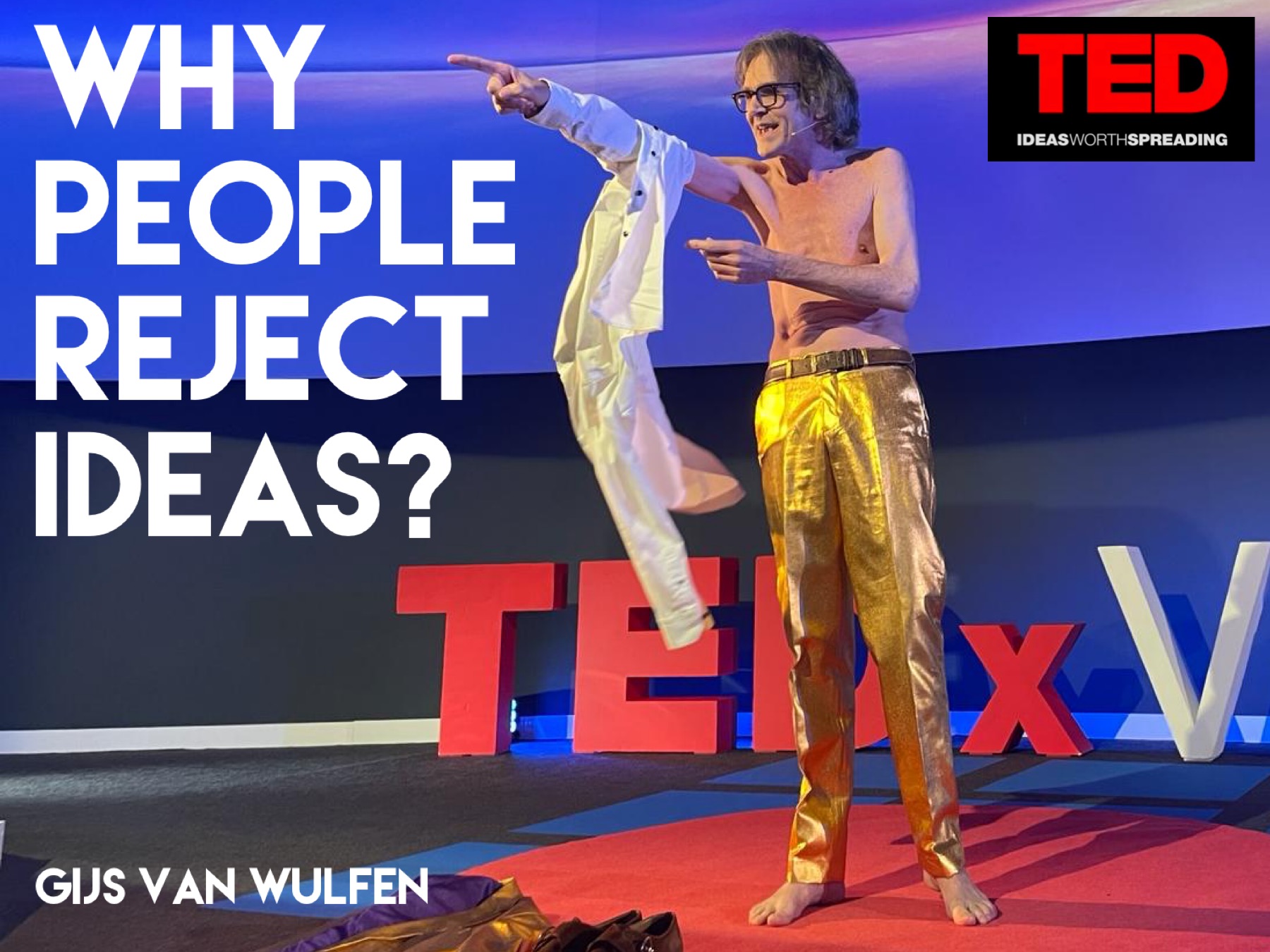 Why People Reject Ideas
Why People Reject Ideas
Why people reject your ideas? Watch this TEDx Talk only when you want to stretch your comfort zone …
As innovator you get a lot of NO’s. People are always so critical when you suggest something new. Why?
The big issue though is that, as Peter Drucker already told us in the 1960s, most of your colleagues and managers have been chosen for their ability to do better instead of their courage to do differently.
Your idea is beyond their comfort zone. When do you stretch your comfort zone? You would stretch your comfort zone for your child .. Right?
Ideas are like children.
People reject your idea because it’s the child of the neighbours.
The best way to get your ideas accepted in your organisation is to co-create or we-nnovate, as I like to call it. Because a new idea in an organisation needs the support of a big family to be able to grow up in a decent way.
Watch this TEDx movie now to stretch your comfort zone: https://Why-ideate-together?-GijsvanWulfen-TEDx
Tags: Design Thinking, Innovation, Creativity
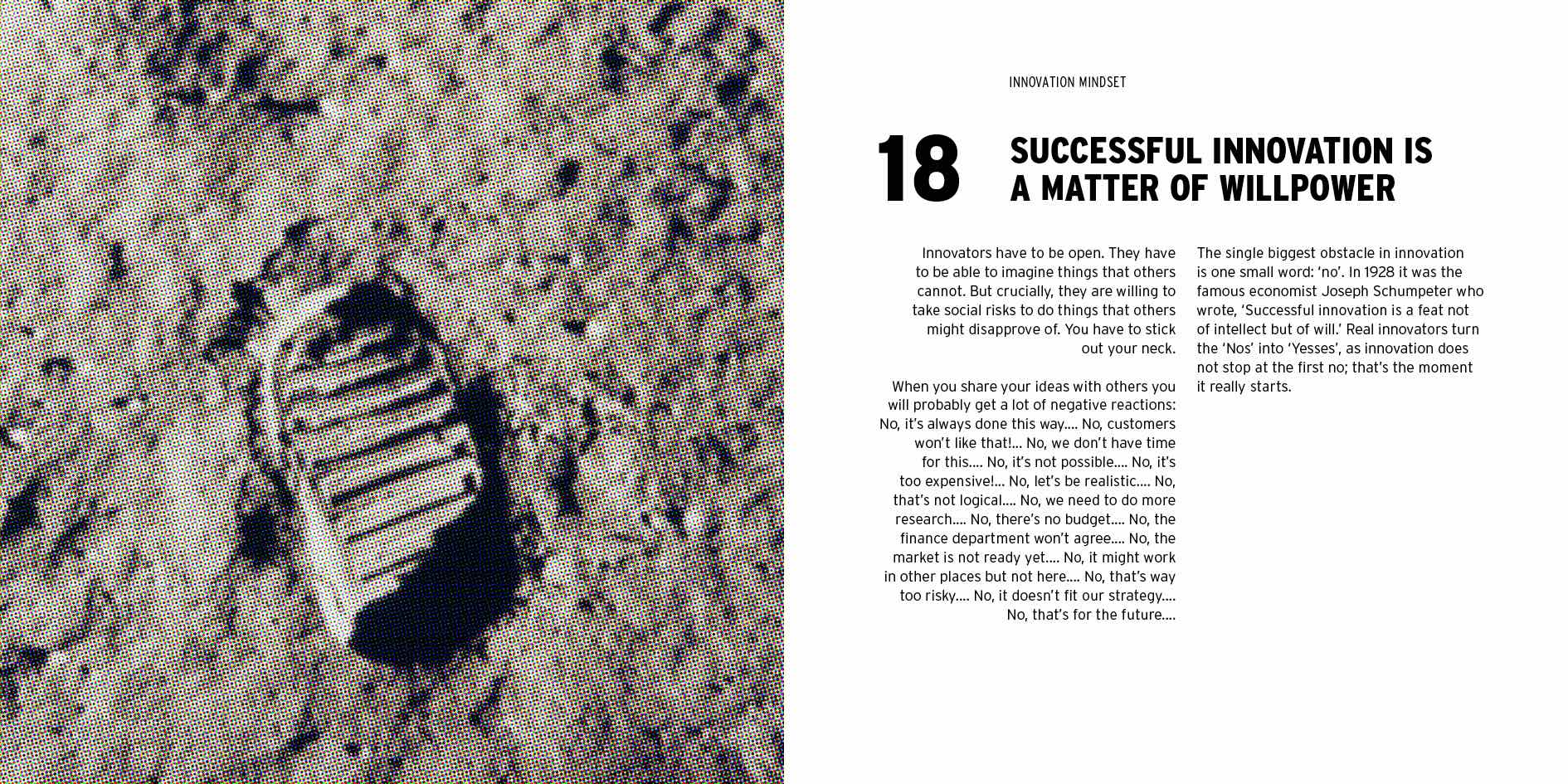 Successful Innovation Is a Matter of Willpower
Successful Innovation Is a Matter of Willpower
Innovators have to be open. They have to be able to imagine things that others cannot. But crucially, they are willing to take social risks to do things that others might disapprove of. You have to stick out your neck.
When you share your ideas with others you will probably get a lot of negative reactions like: No, it’s always done this way... No, customers won’t like that! No, we don’t have time for this… No, it’s not possible... No, it's too expensive! No, let’s be realistic… No, that’s not logical… No, we need to do more research… No, there's no budget… No, the finance department won’t agree... No, the market is not ready yet... No, it might work in other places but not here... No, that's way too risky... No, it doesn't fit our strategy... No, that’s for the future..
The single biggest obstacle in innovation is one small word: ‘no’. In 1928 it was the famous economist Joseph Schumpeter who wrote, “Successful innovation is a feat not of intellect but of will”. Real innovators turn the ‘Nos’ into ‘Yesses’, as innovation does not stop at the first no; that’s the moment it really starts.
Tags: Design, Innovation, Open Innovation
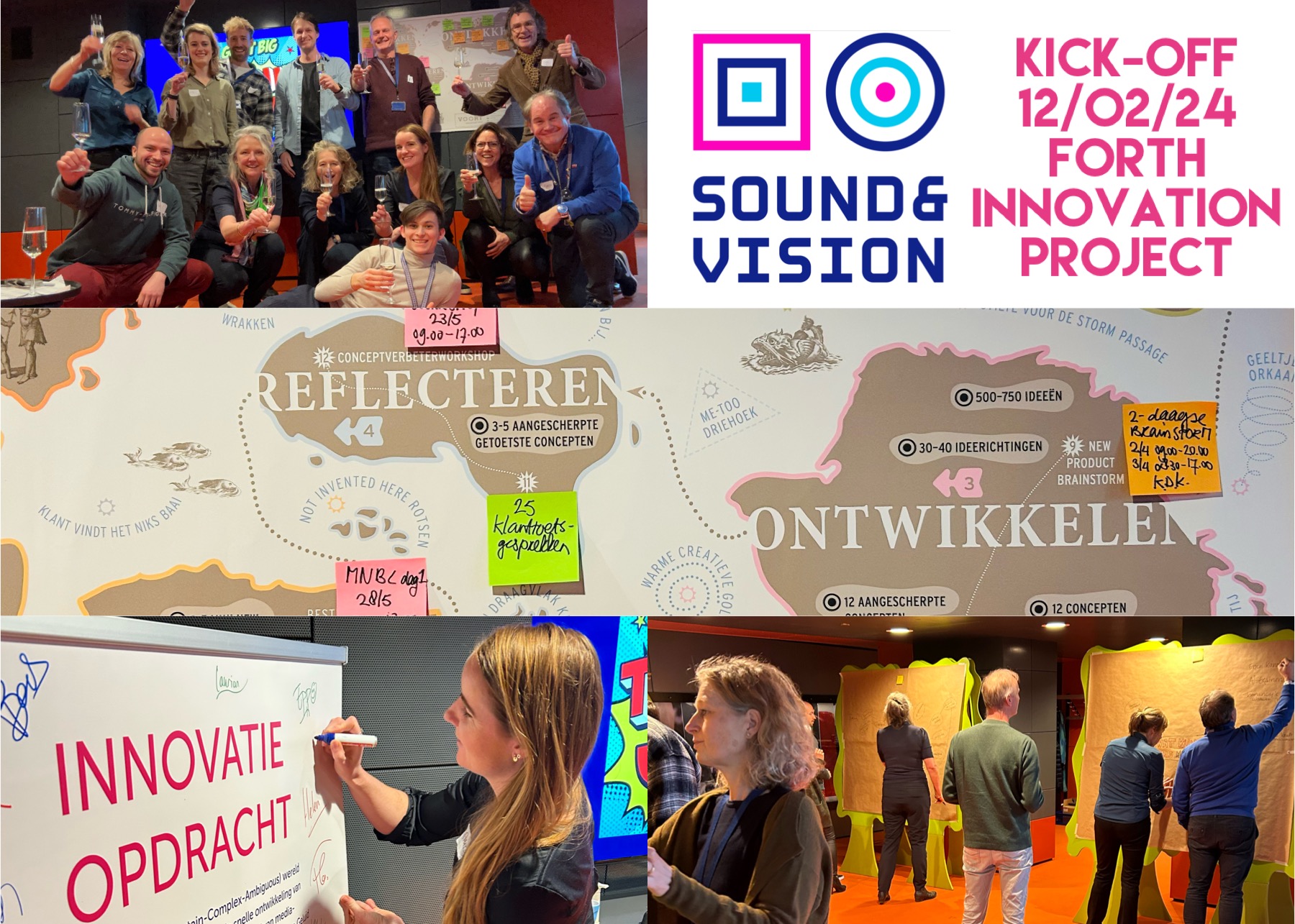 Unlocking Corporate Innovation: The Power of a Great Kick-Off
Unlocking Corporate Innovation: The Power of a Great Kick-Off
Learn how a remarkable kick-off can spark corporate innovation, by checking out ten critical success factors at the start of your innovation journey …
Corporate innovation has become imperative for staying ahead of the curve. However, embarking on an innovation journey is not merely about having groundbreaking ideas; it's about executing them effectively.
And every successful corporate innovation project invariably commences with a stellar kick-off. This pivotal event sets the tone, lays the foundation, and rallies the team towards a common goal. But what distinguishes a great kick-off from a mediocre one? I just started an adventurous innovation journey for the Dutch Media Institute ‘Sound&Vision’ creating new offerings in education last week, with the proven FORTH Innovation Methodology. And we have a marvelous kick-off.
Let's delve into the 10 critical success factors that underpin a remarkable kick-off for corporate innovation.
1. A Clear Innovation Direction
Clarity is paramount when initiating any innovation endeavor. A well-defined innovation direction provides a roadmap, guiding the team towards specific objectives and desired outcomes. It articulates the organization's vision, mission, and strategic goals, ensuring alignment and focus right from the outset.
That’s why we drafted a concrete innovation assignment to get clarity on ‘The North Star’ for the journey.
2. A Team Across All Silos
Effective innovation thrives on diversity and collaboration. Bringing together individuals from diverse backgrounds, skill sets, and departments fosters cross-pollination of ideas and perspectives. Breaking down silos encourages interdisciplinary thinking and enhances the richness of solutions generated during the innovation process.
As Sound&Vision is a matrix-organisation, we connect around 25 people to our innovation journey, to have all disciplines on-board.
3. A Proven Innovation Methodology
Success leaves clues, and leveraging a proven innovation methodology offers a structured approach to ideation, experimentation, and implementation. Whether it's Design Thinking, Lean Startup, or Agile, having a well-established framework provides a systematic way to navigate the complexities of innovation and drive tangible results.
We apply the proven FORTH innovation methodology which combines business thinking and design thinking in a structured journey of 15 weeks as of thr kick-off delivering concrete new business for innovation.
4. Top Management’s Presence
Leadership endorsement is instrumental in fostering a culture of innovation within an organization. When top management actively participates in the kick-off event, it sends a powerful message of support and commitment. Their presence not only reinforces the importance of the initiative but also instills confidence and motivation among team members.
In our innovation journey at Sound&Vision both the CEO and the deputy CEO are closely connected and participate fully in the most important creative - and business workshops.
5. A Safe Psychological Environment
Innovation flourishes in an environment where individuals feel psychologically safe to express their thoughts, share bold ideas, and take calculated risks without fear of judgment or repercussion. Cultivating a culture of psychological safety encourages creativity, promotes open communication, and empowers team members to push boundaries and explore innovative solutions.
It was great to observe in our kick-off that all people participated without hesitation, even with the CEO in the room, whom they don’t meet a lot.
6. An Informal Atmosphere
Formality can stifle creativity and inhibit free-flowing ideation. Creating an informal atmosphere during the kick-off event fosters a relaxed environment conducive to brainstorming, experimentation, and collaborative problem-solving. Whether it's through icebreaker activities, casual discussions, or interactive workshops, setting a laid-back tone encourages participants to engage more freely and creatively.
The creative venue, with only chairs (no tables) sparked an informal atmosphere at our kick-off which co-created the psychological safe environment.
7. A Learning Mindset
Embracing a learning mindset is essential for fostering continuous improvement and adaptation throughout the innovation journey. Encouraging curiosity, embracing failure as a learning opportunity, and promoting a growth mindset cultivates an environment where innovation thrives. By prioritizing learning and development, teams remain agile, resilient, and receptive to new ideas and approaches.
We stimulated an open mindset, sharing notebooks for the journey to pencil down new insights and ideas.
8. Tolerance for Different Views
Innovation is fueled by diverse perspectives and alternative viewpoints. Embracing a culture of inclusivity and tolerance for different views encourages constructive debate, sparks creativity, and stimulates innovative thinking. By valuing and respecting diverse opinions, teams can leverage the collective wisdom and harness the power of varied experiences to drive innovation forward.
In my opening speech as expert-facilitator I stressed that really new solutions in every market are always ‘at the end of your comfort zone’, making a plea for tolerance.
9. Team Buy-In to the Goal
Alignment and buy-in are essential for driving innovation initiatives forward. Ensuring that every team member understands and commits to the overarching goal fosters cohesion, collaboration, and accountability. By fostering a shared sense of purpose and ownership, teams are more motivated and empowered to overcome challenges, iterate on ideas, and drive meaningful outcomes.
That’s why, after explaining the North star of our journey, we ask the participants to sign the innovation assignment as a sign of commitment, which is always a great ritual at the kick-off.
10. Personal Interest
Passion fuels innovation. Encouraging individuals to pursue projects and ideas they are genuinely passionate about cultivates intrinsic motivation and creativity. When team members are personally invested in the innovation process, they are more likely to go above and beyond, persist in the face of obstacles, and deliver impactful results.
So be sure to check their personal interest, when you invite them to board the team. A great way to do this is to claim their full participation, being a participant in every workshop, without exception.
In conclusion, a successful corporate innovation project hinges on a great kick-off that embodies these 10 critical success factors, as we experienced at the start of our FORTH innovation journey at the Sound&Vision Institute.
By establishing a clear direction, fostering collaboration, embracing proven methodologies, and nurturing a supportive environment, organizations can ignite the spark of innovation and propel their initiatives towards success. With top management's endorsement, a safe psychological environment, and an informal atmosphere, coupled with a learning mindset, tolerance for different views, and team buy-in to the goal, fueled by personal interest, organizations can lay the groundwork for transformative innovation.
Ps. Reach out to me when you want to know more about the proven FORTH innovation method or you like to learn how I can help you as innovation facilitator or speaker.
#innovation #forthinnovationmethod #speaker
Tags: Design Thinking, Innovation, Open Innovation
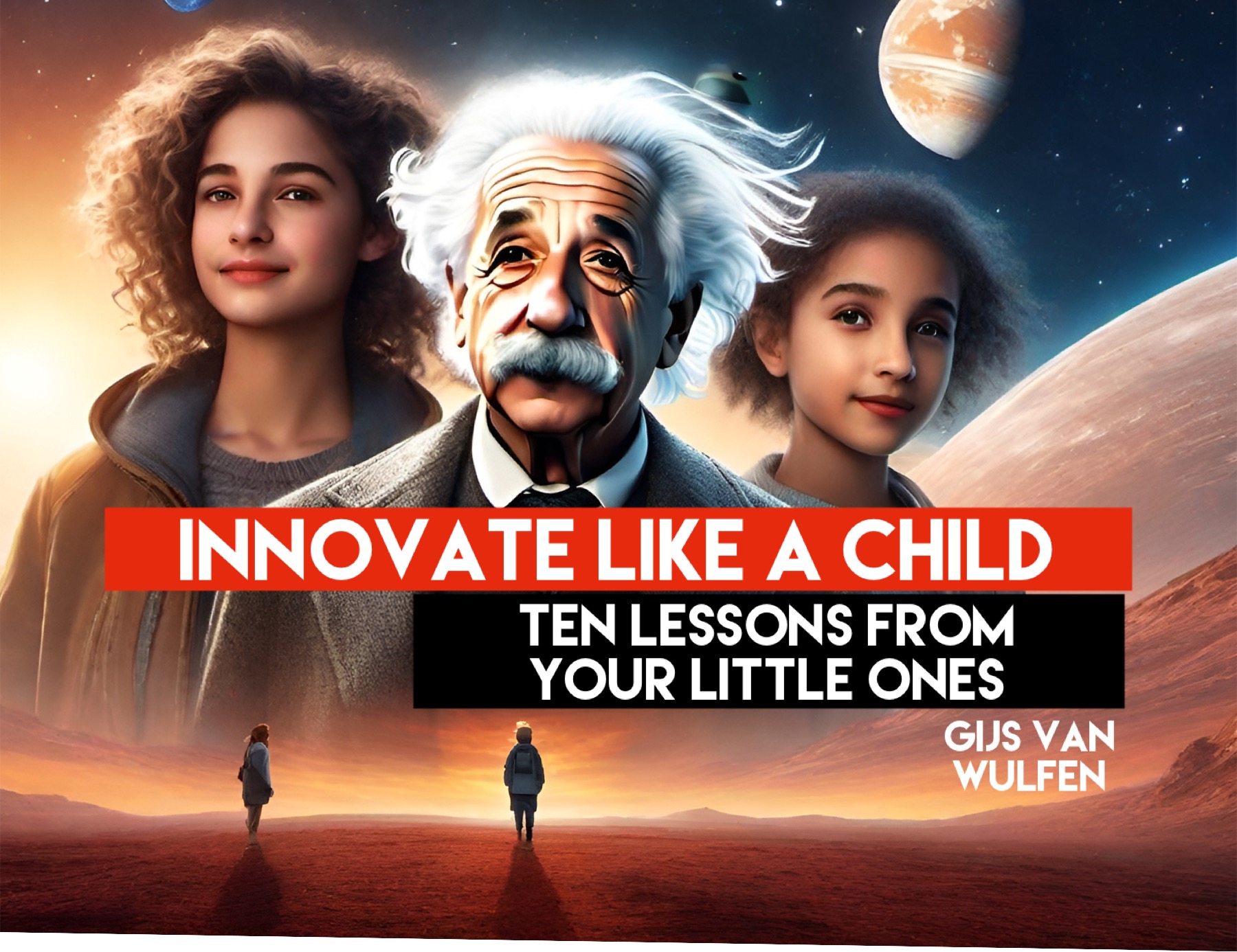 Innovate like a Child: Ten Lessons from Your Little Ones
Innovate like a Child: Ten Lessons from Your Little Ones
As managers, I know it’s easy to get caught up in the day-to-day operations of your organisation. We’re constantly focused on meeting deadlines, hitting targets, and solving immediate problems. But in the midst of all this, we often overlook one of the greatest sources of inspiration for innovation: our children (or grandchildren).
Think about it…
Children approach the world with boundless curiosity, unbridled creativity, and fearless experimentation. They’re not afraid to ask “why” or to try new things simply because they’ve never been done before. As managers, there’s a lot we can learn from our kids when it comes to fostering a culture of innovation in our organisations.
So, here are 10 lessons in creativity and innovation that your children can teach you:
1. Embrace Curiosity: Children are naturally curious beings. They ask endless questions and are always eager to learn new things. As managers, we should encourage this same curiosity among our teams. Encourage them to ask questions, explore new ideas, and never settle for the status quo.
2. Encourage Playfulness: Children approach play with a sense of joy and abandon. They’re not afraid to make mistakes or look silly in the pursuit of fun. As managers, we should create a playful ‘psychological safe’ environment where employees feel free to experiment, take risks, and think outside the box.
3. Foster Imagination: Children have vivid imaginations that allow them to see possibilities where others see limitations. As managers, we should encourage our teams to dream big and think creatively. Create space for brainstorming sessions, idea incubators, and creative workshops where imagination can flourish.
4. Embrace Failure: Children aren’t afraid to fail because they see it as an opportunity to learn and grow. As managers, we should embrace failure as a natural part of the innovation process. Encourage experimentation, celebrate risk-taking, and create a safe space for employees to fail fast and fail forward.
5. Promote Collaboration: Children thrive in collaborative environments where they can bounce ideas off of each other and co-create new worlds. As managers, we should promote a culture of collaboration where teams work together across departments, disciplines, and hierarchies to solve complex problems and drive innovation.
6. Nurture Empathy: Children have an innate sense of empathy that allows them to see the world from others’ perspectives. As managers, we should nurture empathy among our teams by encouraging them to listen deeply, seek feedback, and truly understand the needs and desires of our customers and stakeholders.
7. Embrace Diversity: Children are naturally drawn to people who are different from themselves because they see it as an opportunity to learn and grow. As managers, we should embrace diversity in all its forms – gender, race, ethnicity, age, background, and thought – because diverse teams are more innovative and better equipped to solve complex problems.
8. Celebrate Curiosity: Children love to celebrate their accomplishments, no matter how small. As managers, we should celebrate curiosity and innovation in our organizations by recognizing and rewarding employees who go above and beyond to think creatively, challenge the status quo, and drive meaningful change.
9. Lead by Example: Children learn by watching and imitating the adults in their lives. As managers, we should lead by example by demonstrating our own curiosity, creativity, and willingness to take risks. Be open to new ideas, embrace change, and show your team that innovation starts at the top.
10. Never Stop Learning: Finally, children are lifelong learners who approach each day with a sense of wonder and possibility. As managers, we should never stop learning and growing ourselves. Invest in ongoing training and development opportunities for your team, encourage a culture of continuous improvement, and stay curious about the world around you.
By embracing these 10 lessons from your children, you can unlock a world of innovation in your organization. So, the next time you’re feeling stuck, take a cue from your kids and approach the problem with fresh eyes, boundless curiosity, and a sense of playful experimentation. Who knows what new ideas you might uncover and what great heights your organization might reach as a result?
Tags: Creativity, Innovation, Open Innovation
 How the German Car Industry lost the EV Battle
How the German Car Industry lost the EV Battle
Historically, German car manufacturers BMW, Volkswagen, and Mercedes—were synonymous with innovation and quality in the automotive sector. However, their hesitancy to fully embrace electric vehicles allowed Tesla, and notably Chinese car makers, to seize the reins of the rapidly growing EV market.
In 2006, Elon Musk outlined his mission for becoming the market leader with electric cars. He started with luxury cars to generate revenue, then introduced high-quality mid-range vehicles and finally brought a vehicle onto the market at a particularly low price that no other could match. Tesla plans to increase production capacity in Berlin to one million cars per year in the future and will soon bring a €25,000 electric vehicle onto the market, which will be a game changer.
While Tesla aggressively pursued electric vehicle technology, German automakers initially hesitated, focusing on their successful lines of internal combustion engine vehicles. This delay, in part, was influenced by concerns about the feasibility of EVs, charging infrastructure, and potential cannibalization of their existing profitable products. But above all it gad to do with taking risks.
I like to quote the CEO of BMW AG, the German luxury car producer, Dr.-Ing. Norbert Reithofer, from an article exactly ten years ago. When asked why BMW started the risky E-car project with the BMWi-3 and i-8 he responded very honest: "Because doing nothing was a bigger risk ..." [Autoweek 41-2013].
As the world witnessed a paradigm shift towards sustainable mobility, Tesla and Chinese EV manufacturers surged ahead, capturing market share and establishing themselves as leaders in the electric vehicle space. Recent data reveals a significant disparity in electric vehicle sales, with Tesla dominating the global market, and Chinese brands making substantial inroads. In Germany, the ramp-up of e-mobility is slowing down - and China is increasingly dominating with brands like NIO, BYD, Geely, XPeng Motors, Li Auto and GWM.
The Chinese are already leading the way as you can see below
Global Electric Vehicle Sales (2022):
(Data source: International Energy Agency, 2022)
Lessons Learned
The German automotive giants' experience serves as a cautionary tale. To navigate 'The Innovator's Dilemma,' you must be proactive in embracing disruptive innovations, even if it means challenging their existing successful paradigms and taking risks. In the rapidly evolving landscape of electric vehicles, early adoption and innovation proved to be decisive factors in building market leadership.
Are you proactive in innovation in the markets which you are leading for a long time …?
Innovative regards,
Gijs van Wulfen
Global Speaker on Innovation, Founder FORTH innovation method, LinkedIn Influencer 300.000+, Author of Management Book of the Year, Milano, Italy
Tags: Culture, Innovation, Open Innovation
 No, AI is not overhyped
No, AI is not overhyped
Here’s a list of 150 AI-powered products and services ….
And of course 151. AI-powered blog posts .
Most of these AI products, and thousands more, are becoming reality now or within three years, I predict.
In applying our FORTH Innovation Method to generate new innovations with corporate clients generative AI is adding value in twenty five ways, during our innovation journey.
How's generative AI empowering your offerings to your clients?
Tags: AI, Innovation, Open Innovation
 The most common mistake in innovation
The most common mistake in innovation
The most common mistake is to make one person or a small group responsible for innovation. That's strangles innovation slowly as the following happens:
The director calls everyone together for an announcement. “We have to innovate! And you know what? John will be our new innovation director. Please give him all your support”. The rest of the team then wishes John good luck and sits back awaiting his plans and initiatives. But that year John will never achieve the desired results, as he came up with great ideas all right, but nothing materialized. And that’s what innovation actually means: transforming ideas into reality. The rest of the organization wass focusing on the short term, way to busy to spend time and money on John’s ideas for the future.
The most common mistake is to monopolize innovation, as you can’t innovate alone. You can only innovate together.
The secret sauce is to create collective ownership for innovation and start to We-nnovate, instead of I-nnovate.
Tags: Entrepreneurship, Innovation, Open Innovation
 Which are the Most Innovative Countries of the World?
Which are the Most Innovative Countries of the World?
The WIPO presented the Global Innovation Index 2023 ranking 132 countries on their innovation capabilities. "Two promising innovation waves are making their presence felt across economies and societies: a digital innovation wave, built on artificial intelligence (AI), supercomputing and automation, and a deep science innovation wave, based on biotechnologies and nanotechnologies.
Many of the key indicators of technological progress are trending positively. Computing power continues to increase in line with Moore’s Law. Green supercomputing is becoming more efficient. Renewable energy is increasingly affordable. And the cost of genome sequencing continues to decline. Spurred on by the scale of the possibilities before us, top corporate R&D expenditure exceeded USD 1 trillion for the first time last year, with ICT firms the primary drivers", according to the WIPO.
Switzerland – for a 13th year – ranks first in the GII 2023. Sweden is now 2nd and the United States 3rd, followed by the United Kingdom (4th) and Singapore (5th), which enters the top 5.

Finland (6th) moves closer to the top 5, and every other Nordic (Denmark 9th and Sweden) and Baltic (Estonia, 16th, Lithuania 34th and Latvia 37th) economy is also on an upward trend, except for Iceland, which stays stable at 20th position.
China – still the sole middle-income economy within the GII top 30, having entered the top echelon in 2014 – is ranked 12th in GII2023, while Japan is 13th. Israel (14th) makes it into the top 15. Saudi Arabia (48th), Brazil (49th) and Qatar (50th) make it into the top 50, and South Africa (59th) into the top 60. Indonesia (61st) joins China, Türkiye (39th), India (40th), Viet Nam (46th), the Philippines (56th), and the Islamic Republic of Iran (62nd) in the group of middle-income economies within the GII top 65. This is the group that has climbed the GII rankings fastest over the last decade.
Outside the top 65 but within the top 100, the following middle- and low-income countries have progressed the most – by more than 20 ranks – within the last decade: Morocco (70th), Uzbekistan (82nd), Egypt (86th) and Pakistan (88th). In the last four years, and since the pandemic started, Mauritius (57th), Indonesia, Saudi Arabia, Brazil and Pakistan have risen the most in rank (in order of rank progression).
Below you can see the top three economies by region. Both Brazil and Singapore are new innovation leaders in their region in 2023.

What strikes me personally is that a country Like Japan, which is with the Tokyo-Yokohama region the number one Science & Technology Cluster in the world is not even in the top 3 countries in their region, and ranked number 13 in the global index of 2013. It's proof that great inventors do not have to be great innovators.
So, how did your country score? And are you happy with that? Start contributing to help your economic region be a better innovator for a better world!
Innovative regards from Milano,
Gijs
LinkedIn TopVoice, Founder FORTH Innovation Institute, Keynote Speaker
Tags: Culture, Entrepreneurship, Innovation
 Why Improvement Beats Innovation
Why Improvement Beats Innovation
Did you ever wondered why improvement beats Innovation every time?
Check it out …
In the board room at moments of decision making by risk-avoiding top managers, improvement beats innovation. That's why Operational Excellence, Lean and Six Sigma got so popular. Effective innovators have to pick the right moment: when ‘doing nothing is a bigger risk’.
Read here why ....
Innovation is a vague word. Everybody agrees that is all about something new. But wait until you ask "what do you mean by new....?" Let's take as example the iPhone of Apple. Which of the following 10 new iPhones of Apple do you consider an innovation?
1. the first iPhone: June 2007
2. iPhone 3G: with 3G en gps.
3. iPhone 3Gs: with video.
4. iPhone 4: with a modern design and a lot more pixels.
5. iPhone 4S: with an improved camera and ‘Siri’, the digital assistent.
6. iPhone 5: with a large screen and lighter aluminium cover.
7. iPhone 5s and iPhone 5c: with cosmetic changes and ‘touch-identification’.
8. iPhone 6 and iPhone 6 Plus: with a modern design and in a larger version.
9. iPhone 6s and iPhone 6s Plus: with some small improvements.
10. iPhone SE: smaller and a bit less expensive.
Well? I think that only the first iPhone is an innovation. All other 9 iPhones are improvements of the original. In my view there are clear differences between improving and innovating.
Innovation versus Improvement
1. discontinuous versus continuous;
2. 'in jumps' versus 'in steps';
3. 'uncertain outcome' versus 'certain outcome';
4. 'in all directions' versus 'straight ahead'.
5. 'vague and iterative' versus 'clearly structured'.
6. 'high risk' versus 'low risk'.
7. 'big investment in time and money' versus 'small investment in time and money'.
8. 'for the day after tomorrow' versus 'for tomorrow'.
You innovate in high risk jumps, and you improve in small steps according to a planned process with a clear goal. With a small investment and a little chance of failure, you attain an almost certain outcome on short term. Real innovation happens now and then. It's often a vague iterative process with an uncertain outcome on longer term. Innovation demands a bigger investment, both in time and money, while you are not sure what will materialise in the end.
Lots of organisation have started continuous improvement programmes. They are using 'Lean' and 'Six Sigma' successfully making small steps with little uncertainty. And that's what we like. Improvement is very popular and beats innovation.
The origin of all the opposition to innovation is that in essence most people and companies avoid risks. Moving beyond what they normally do makes them uncertain. In my keynote soeeches on innovation I ask, “Who of you wants to be an innovator?”. Most hands go up in the air. When I follow up with, “Who of you wants to run a personal risk?” a lot of those hands go back down. For corporate innovators it’s very frustrating when you’ve been assigned to come up with great new ideas only to see nothing materialize because the same managers who gave you your assignment say ‘no’ to every idea, business case or prototype you present. The reason why so few real innovations hit the market is that people are risk averse. Most of us, also your leaders, will approve real innovations when we are aware that improvements cannot generate any growth anymore.
I like to quote the CEO of BMW AG, the German luxury car producer, Dr.-Ing. Norbert Reithofer. When asked why BMW started the risky E-car project with the BMWi-3 and i-8 he responded very honest: "Because doing nothing was even a bigger risk".
As effective innovator, you have to pick your moment. There are two sweet spots when innovation can beat improvement.
In practice, I see those who want to innovate and those who need to innovate. I call those who want to innovate the active innovators and the ones who need to innovate the passive innovators. As you can see in the chart their roles are defined by the moments they really innovate their business. Every company, business unit or product has its lifecycle of introduction, growth, maturity and decline.
Active innovators, who want to innovate, give innovation priority at the end of the growth stage. Before they reach maturity they want to innovate, often for several reasons simultaneously:
• To keep their revenue stream growing;
• To maintain an innovative mindset;
• To boost internal entrepreneurship (intrapreneurship);
• To address changing needs and wants of customers;
• To lead in technology;
• To expand their business by new business models, distribution channels and customer groups;
• To anticipate on new governmental regulations or a market liberalization.
Reactive innovators, on the contrary, wait. They wait until they get hit by a crisis, their markets saturate or get disrupted by new technologies and/or business models. They reorganize, lay-off people and prioritize innovation only at the start of their decline stage when they need to innovate. They need to innovate most often with only one goal in mind: to stop revenues and profits from falling and build a new future for their organization.
Both types of innovators have their own challenges. The good news for active innovators is that there are plenty of resources available as the company is doing well at the end of the growth stage. Their challenge is to cope with a lack of urgency at the operational level of the organization: “Why should we innovate? We’re damn busy and doing great!” The good news for the reactive innovators is that there’s great urgency also at the operational level of the organization, as there’s often been a collective layoff due to the business slow-down. Their challenge is compounded by both a lack of resources and a lack of time, as they will have to move quickly.
The central question is not if you should innovate. It’s WHEN and HOW you start and lead innovation effectively. My tip for you personally is to pick the moment innovation has a chance to beat improvement.
Wishing you lots of success on your innovation journeys. Innovative regards from Milano,
Gijs van Wulfen
LinkedIn Influencer
Global speaker on innovation
Founder FORTH innovation methodology
Tags: Creativity, Design Thinking, Innovation
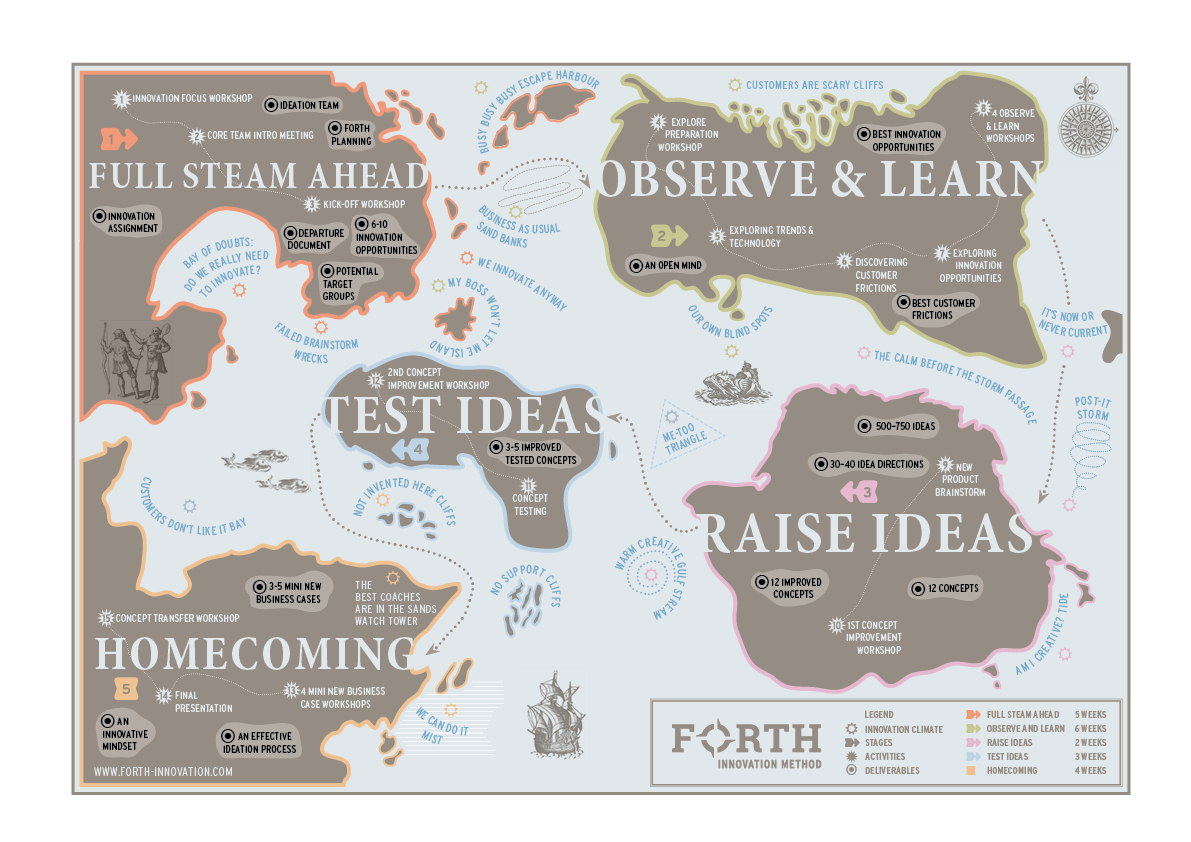 Double Your Innovation Effectiveness with The FORTH Innovation Method
Double Your Innovation Effectiveness with The FORTH Innovation Method
Location: Milan, Italy Fees: 95.000
Service Type: Service Offered
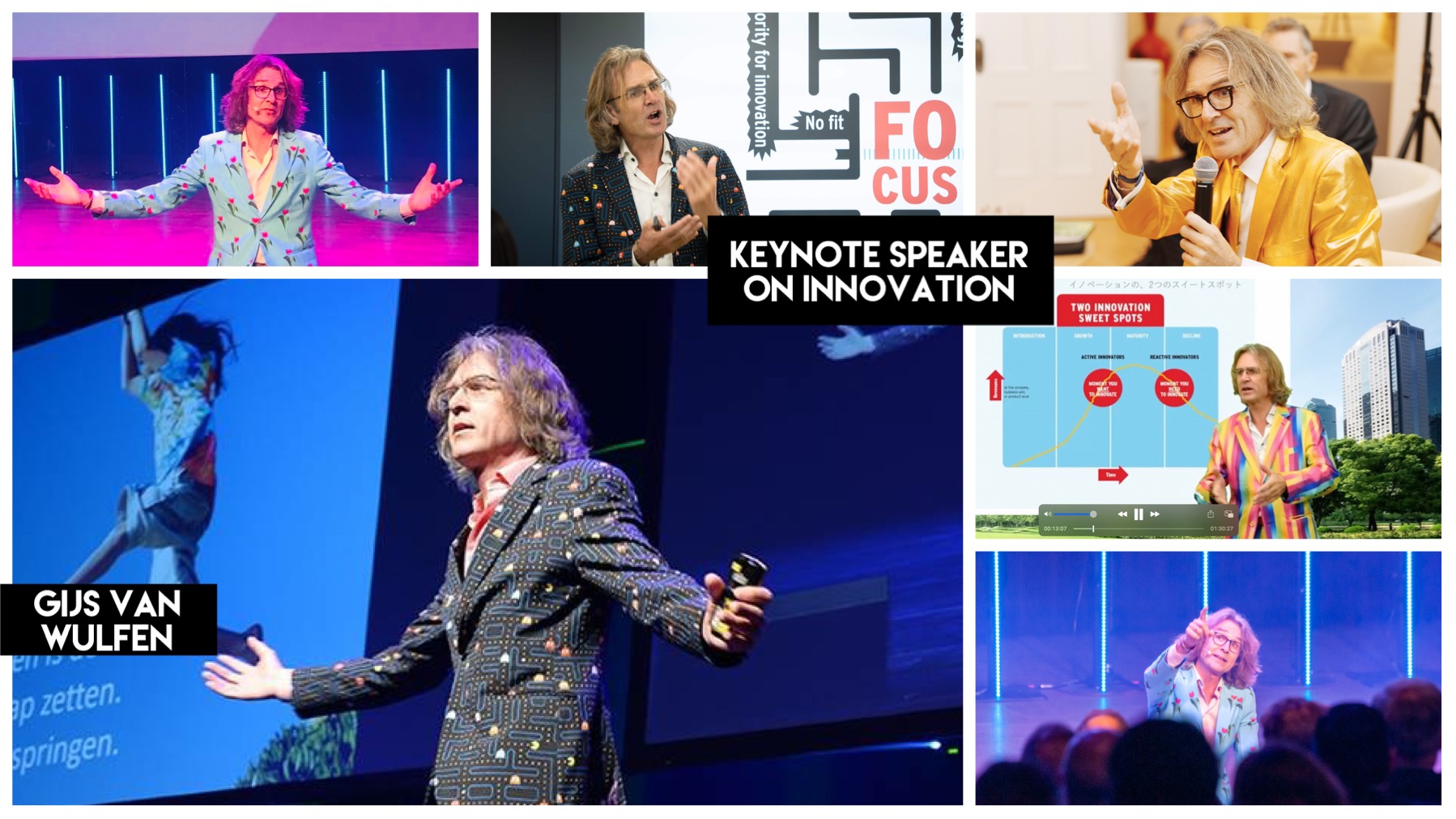 Ten Guidelines on Your Path Becoming an Amazing Innovator
Ten Guidelines on Your Path Becoming an Amazing Innovator
Location: Milan, Italy Fees: 10.000
Service Type: Service Offered
 Certified FORTH Innovation Training Japan - May 2025
Certified FORTH Innovation Training Japan - May 2025 Certified FORTH Innovation Training Italy - June 2025
Certified FORTH Innovation Training Italy - June 2025 Doorbreek Innovatiebarrières
Doorbreek Innovatiebarrières How to Make Executives Say Yes to Your Innovation Projects
How to Make Executives Say Yes to Your Innovation Projects Six Innovation Hats. Which One Fits You?
Six Innovation Hats. Which One Fits You? Win Management Buy-In for Innovation with Fifteen Proven Strategies …
Win Management Buy-In for Innovation with Fifteen Proven Strategies …